Cooperation: Koji Yamazaki, Riki Japan
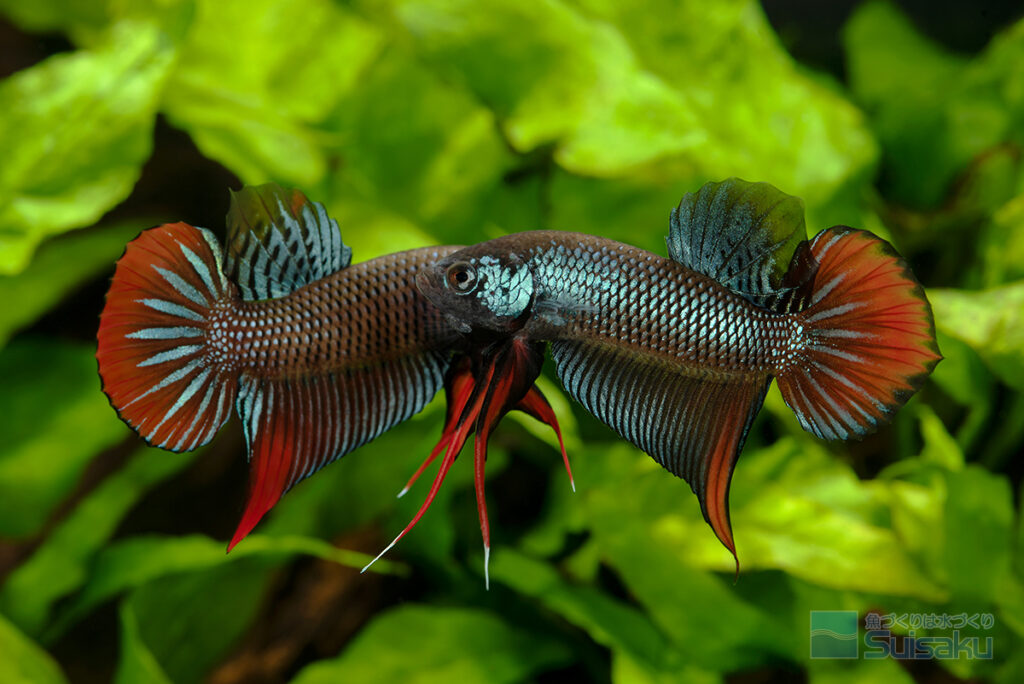
first
In the second installment of this series, we will introduce you to Betta Wild Cross. I first became fascinated with bettas several decades ago when I was in elementary school. When it comes to bettas, the most common bettas are what we now call veil tail bettas, which at the time were called average bettas or traditional bettas. The main colors were blue, red, and a mixture of those colors. As a young boy, I was impressed by the beauty of the males and the interesting breeding behavior of creating bubble nests, and I fell in love with betta fish. From the 2s to the 1980s, domestic betta became popular, and from the late 90s to the early 90s there was a rush to improve fish in Thailand, and the current boom that continued after that. Seeing the betta movement up close, I realized the potential of betta fish. I'm just amazed. From 2000 to 2006, I was in charge of serializing ``THE BETTA MODE'' in Monthly Aqua Life. We introduced the latest improved betta, but at that time it still felt like an item for enthusiasts, and it wasn't until 2008 when the beautiful Koi betta appeared that it became a boom in Japan. Since then, attractive varieties such as Candy (Nemo), Galaxy, Samurai, and Blue & Black (Avatar) have appeared one after another to the delight of enthusiasts. For information on the latest betta varieties, etc., see Koji Yamazaki'sSmall Beauty WorldYou can see it here, so please take a look. You can experience the charm and depth of Betta. Well, the introduction has become long, but it's Wild Cross. Let's take a closer look at its charm and breeding.
What is Wild Cross?
Wild Cross is a word that combines Wild and Cross, and refers to "Wild = original species and Cross = hybridized betta". Wild Hybrid It is also called Wild Hybrid. The basics of breeding is to use original species, but there are no strict regulations, and in general, those born from breeding between original species that look like the original species and have a flashy color like an improved solid are called wild crosses. .
The fish that the improved Betta is based on is an original species called Betta splendens, and all six species, including closely related species, are called the splendens group. Wild crosses are produced by crossing bettas from this group. Depending on the breeder, they may use two or three species by crossbreeding, or they may steadily fix the color change from one species. However, individuals that are born through successive breeding between the same species and retain strong traces of their original parents are better called aquarium strains (strains developed in captivity) rather than wild crosses.
splendens group betta
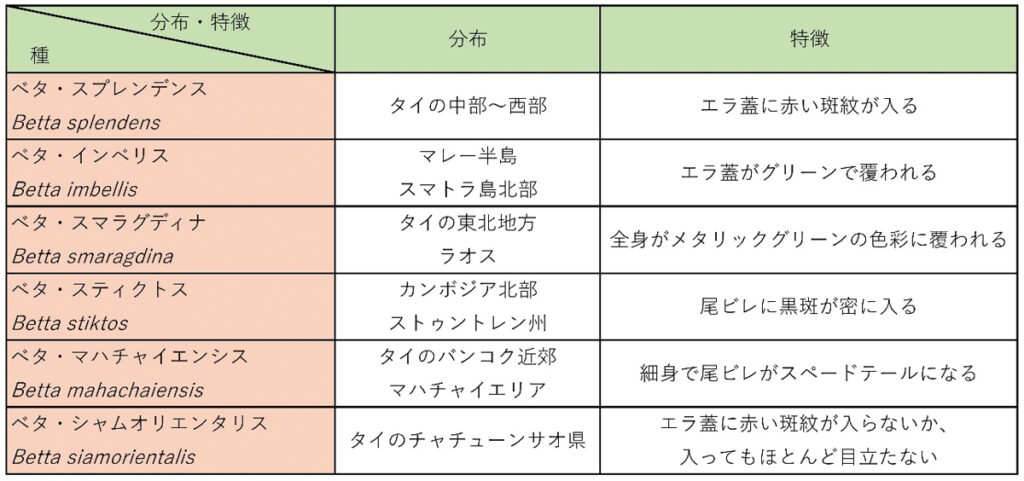
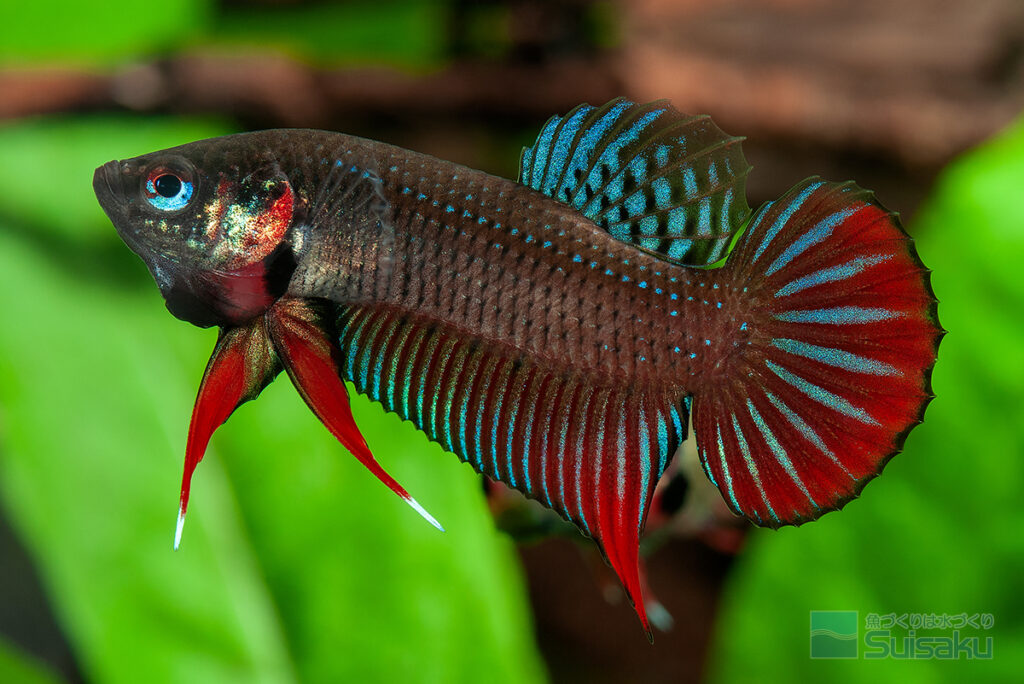
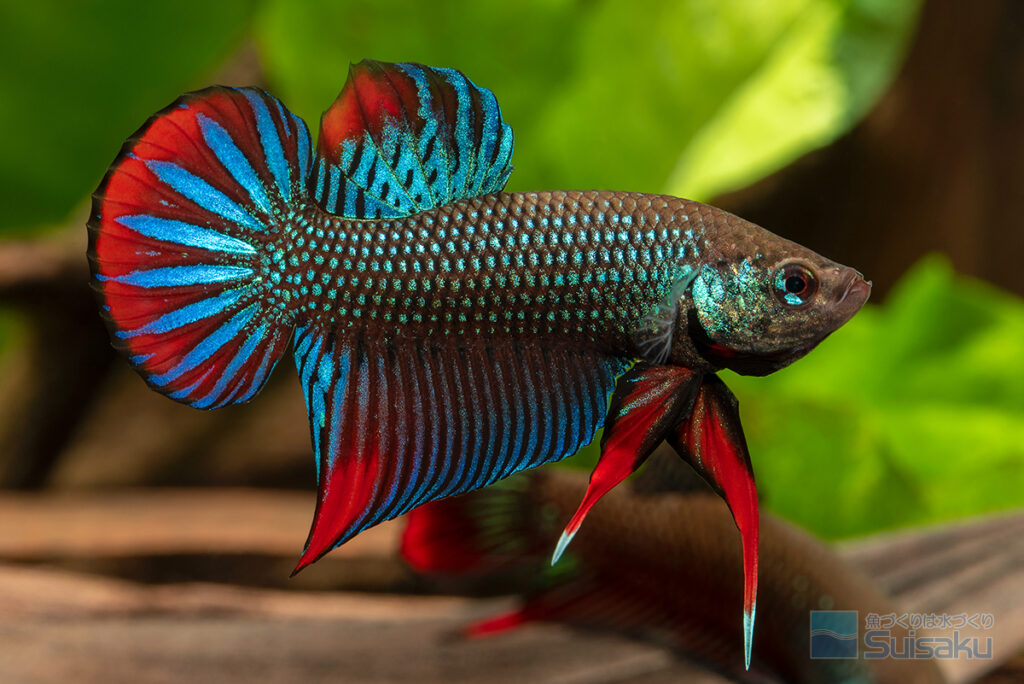
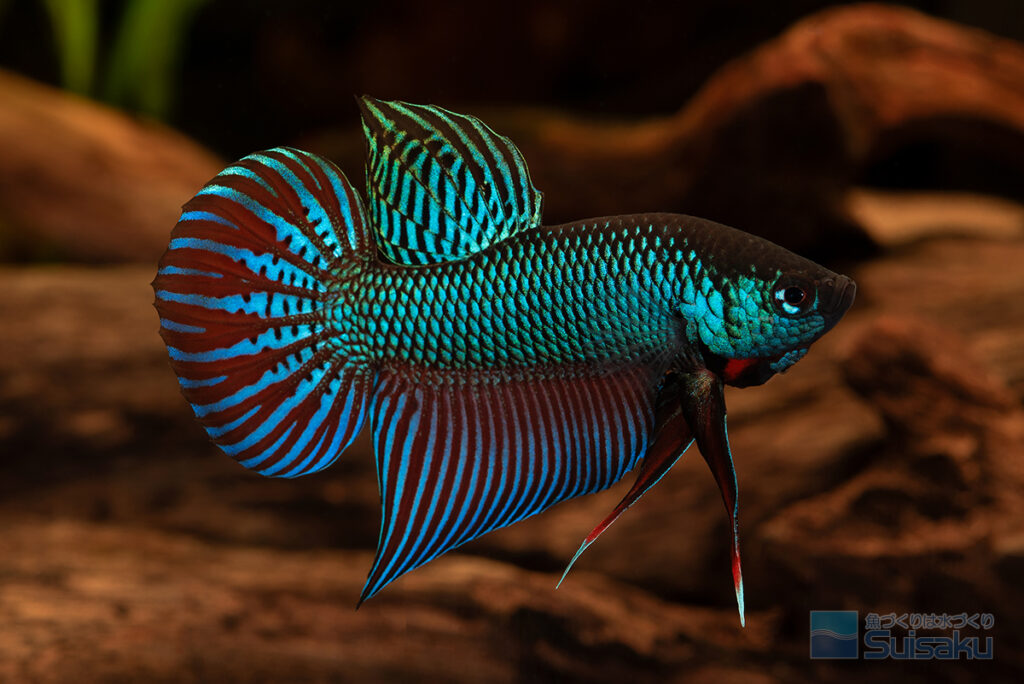
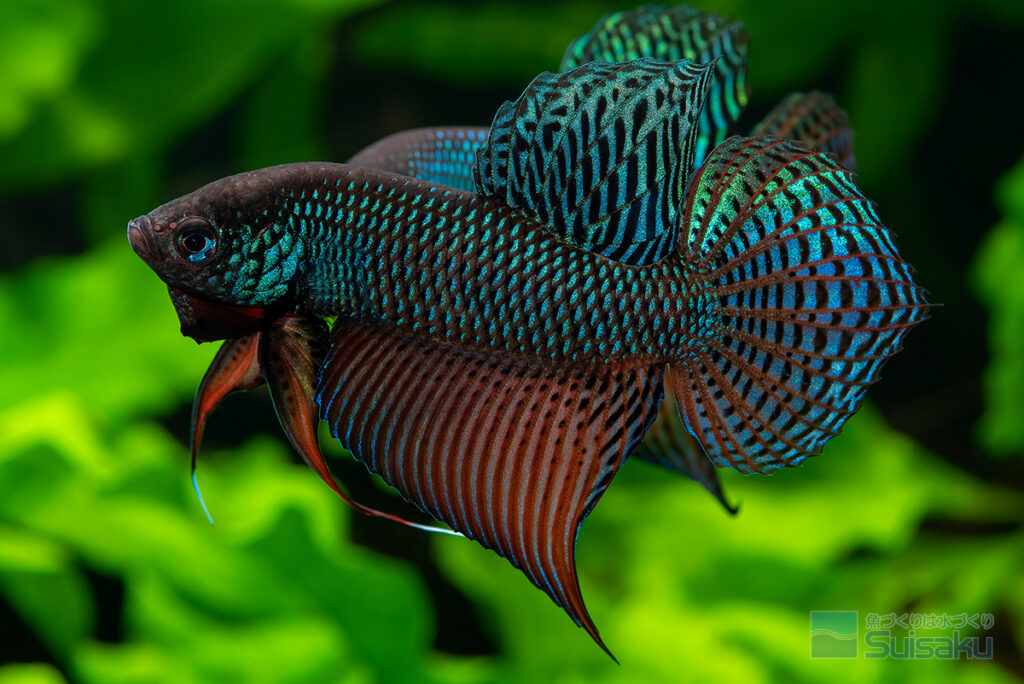
When it comes to wild crosses, it is not possible to create the beautiful varieties that many enthusiasts claim by simply crossing different species. Through cross-breeding, we find promising raw stones, and then repeat selection and cross-breeding to create beautiful fish. Just like goldfish, Nishikigoi, and killifish, it requires steady work. A Thai breeder I know has produced beautiful individuals over 10 generations. When you hear this, you may think it took a very long time, but if you do it right, it is possible to update 1 to 3 generations of Beta in a year, so it is possible to update 4 generations in 3 years. In Thailand, where it is hot all year round, they can be kept outdoors all year round, so breeding can be done efficiently.
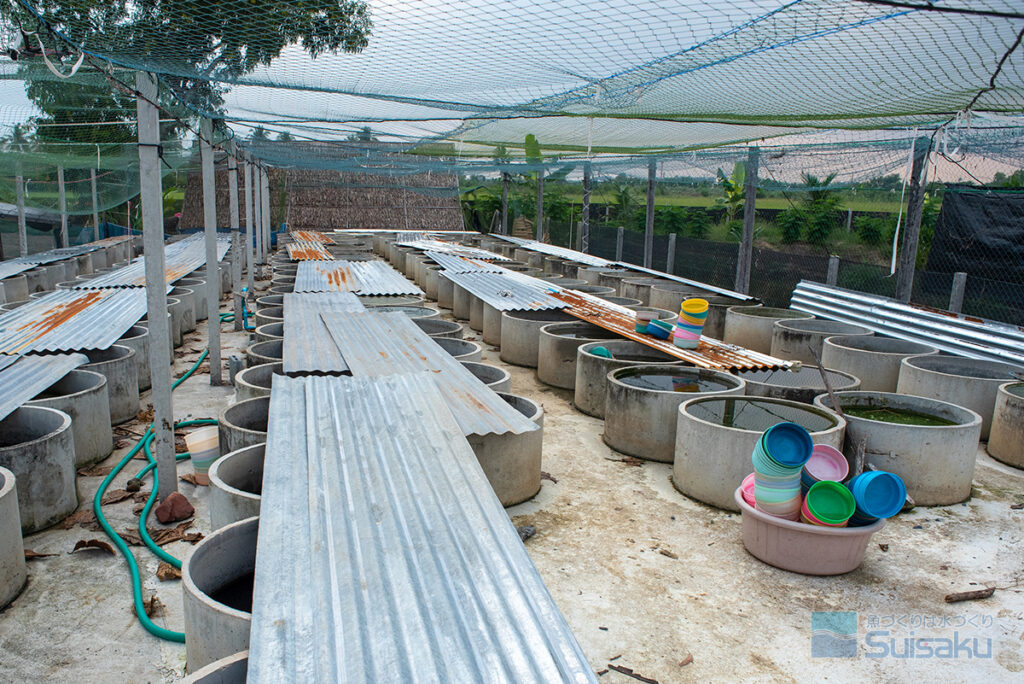
History of Wild Cross and notable aliens
The category of wild crosses has only recently become established, but of course crossbreeding between different species and the creation of different colors between species of the same species have been carried out for a long time. For example, there was a variety called "Metallica" from Inveris that was well known to long-time Betta enthusiasts. This is a beautiful variety of Inveris that was created in the 1980s and has a metallic blue-green color covering its entire body. Inveris had an atmosphere similar to the blue-green color of the original Inveris Silver introduced at the beginning. This breed had a great influence on the improvement of betta fish, and it seems that from this point on, blood from different species was gradually used in improved betta fish.
Since then, various crossbreeding efforts have been made in Thailand, centering on the Plakat. And it seems that the current trend of wild crosses started around the individuals created in 2011. I introduce wild crosses on pages 164-2014 of my book “Betta 48 Breed Introduction and Breeding Explanation” (MPG, 49), and the wild dragon placats “Flash Blue” and “Black Emerald” published there are As an individual with strong traces of its original species, it well represents the characteristics of the Wild Cross at the time. In addition, individuals that are thought to be hybridized with Plakat have also been seen here and there.
The main characteristic of individuals that have been crossed with the original breed is that their bodies are longer and slender compared to other improved bettas, and as you get used to them, you will be able to tell at a glance that they have the blood of the original breed in them. While many breeders were looking for ways to create bright and beautiful patterned solids, the fact that there was a breeder in 2011 who was producing solids with such a dark color is a great achievement for Thailand. I guess it shows how deep it is. However, at that time, even in Thailand, the response from enthusiasts was weak, or rather, there was almost no reaction, and only a few enthusiasts who liked the original species were instructed to do so. I think the only Japanese people who were paying attention were me and Mr. Yamazaki (lol).
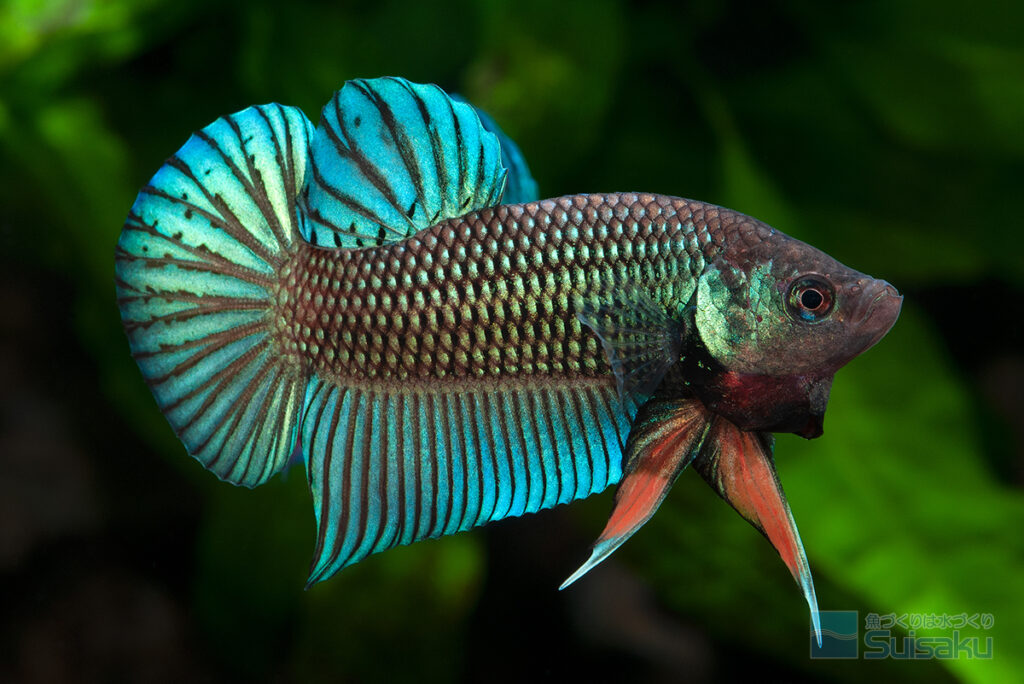
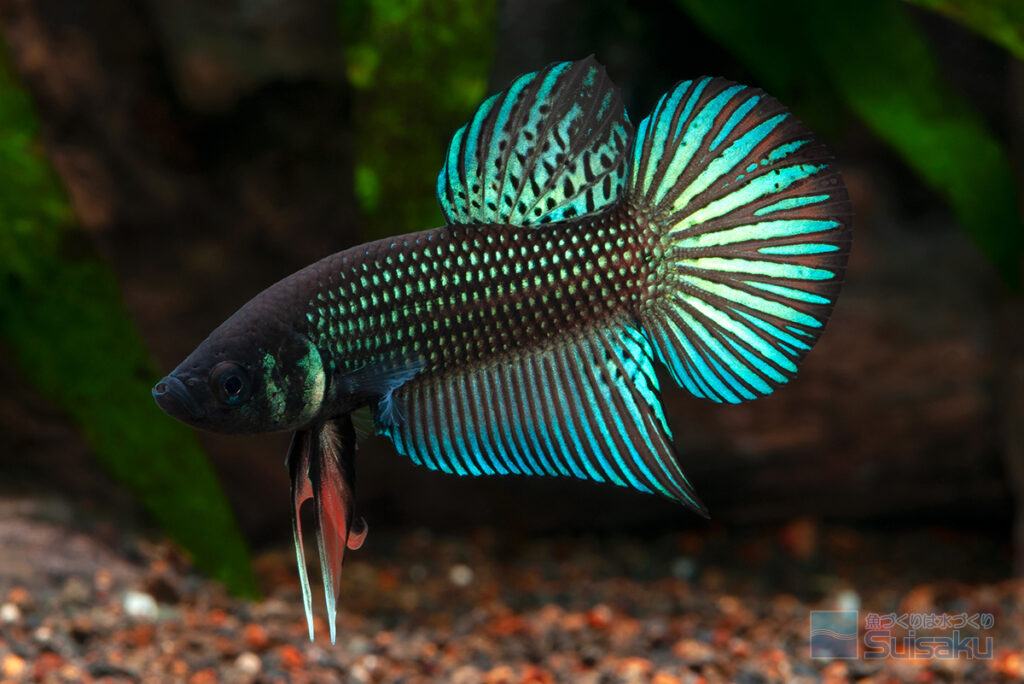
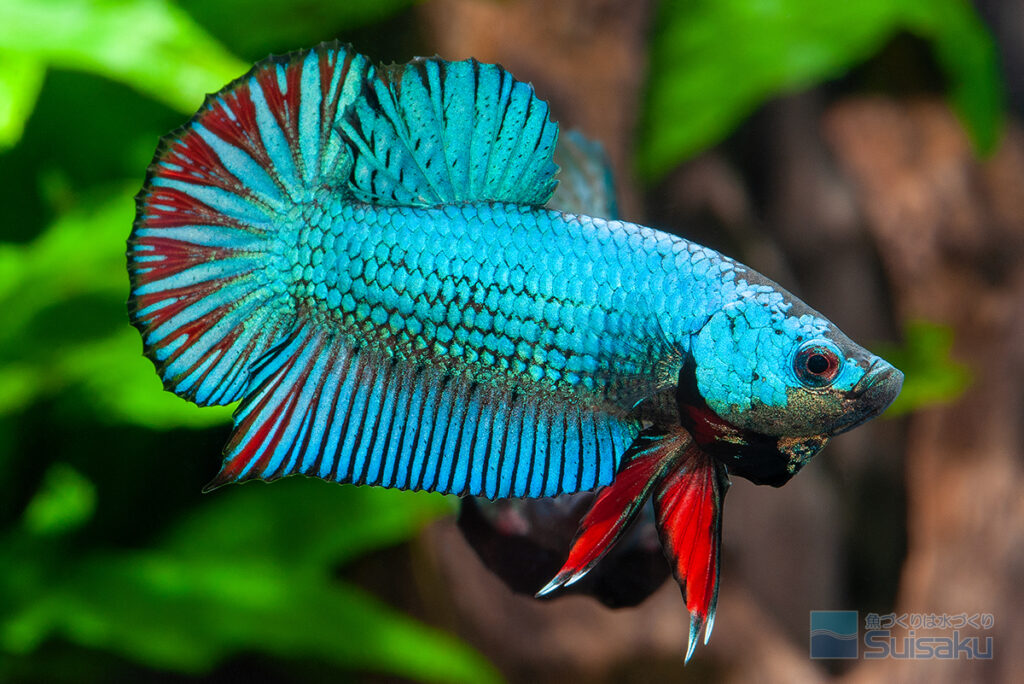
The book advocates the Wild Cross genre, but we had to wait until a certain breed appeared before this genre became recognized in Japan. That is Alien, which appeared in 2016. In Japan, it is sometimes distributed under the common names Symphony and Triple Cross, but in Thailand, it is usually called Alien, and this area is referred to in Mr. Yamazaki's content "Episode 77 Alien Gold” for more information, please refer to it. This alien fish was bred from three species, the original species Smaragdina "guitar", Styctus, and Mahachaiensis, and its dazzling color with its whole body covered in vibrancy is attractive. The characteristics of the fins of the original species are well reflected, resulting in a beautiful ornamental fish, and there is no doubt that it became a betta fish that remains in the memories of many enthusiasts. When it was first announced, the shape of its fins and the arrangement of its scales were unstable, but improvements have now progressed, and you can now see wonderful individuals with sharp, beautiful fins with even scales.
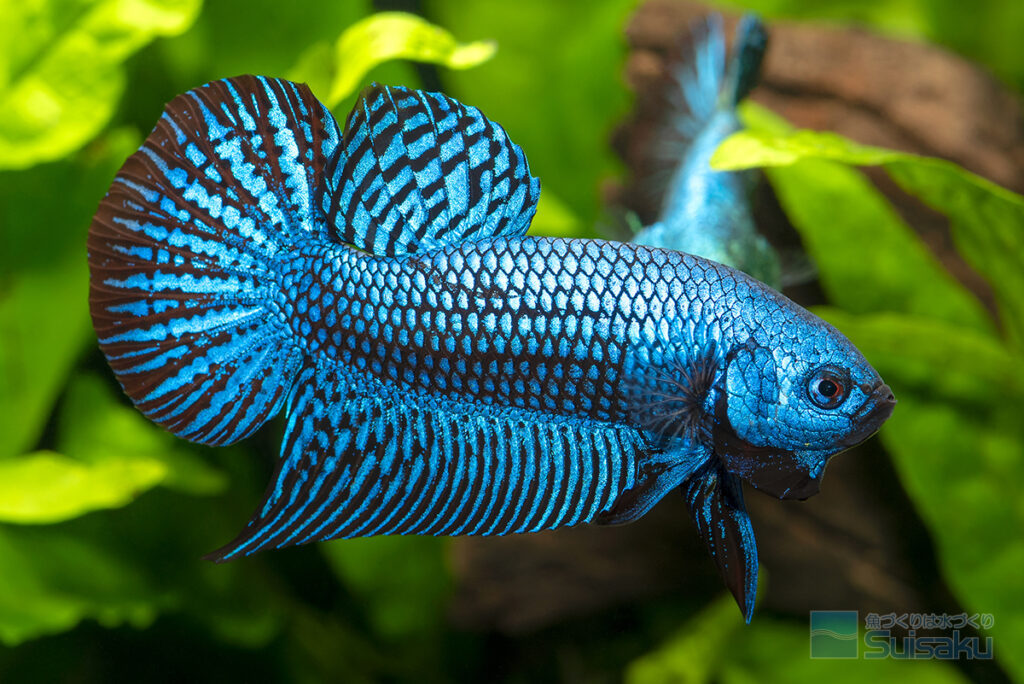
Attractive wild crosses
As expected, when a popular variety comes out, there is a big movement. After the announcement of Alien, Wild Cross began to attract attention, and improvements using the original species became active. Individuals with strong blood lines such as Inbellis, Smaragdina, and Mahachaiensis are becoming more prominent, and recently, a variety called "Benjaron", which is an improved version of Betta Splendens that was announced in 2020, has become a hot topic. It is said to have been bred from a local population in Purua District that grows into a spadetail, and is a beautiful fish with a vermilion red color over its entire body, but this year a yellow form with a yellow color has also been released. If there is red, Thailand will make yellow. As expected. By the way, Benjarong is a traditional multicolored pottery made during the Ayutthaya Dynasty in Thailand, and means five colors in Sanskrit. This means that after red and yellow, we may see the creation of another color. I'm looking forward to it.
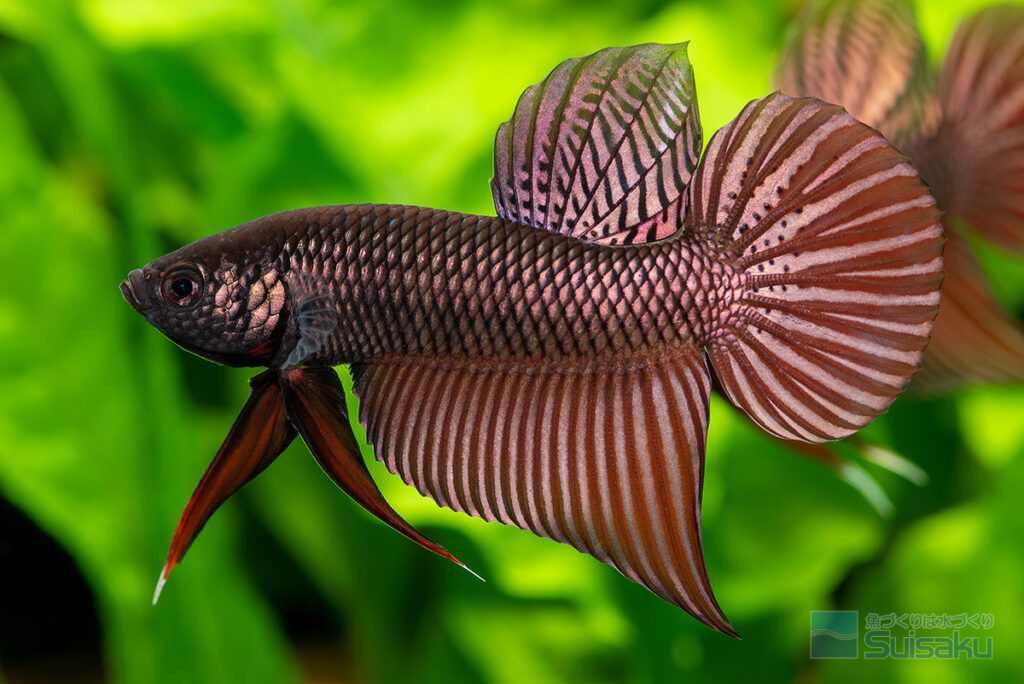
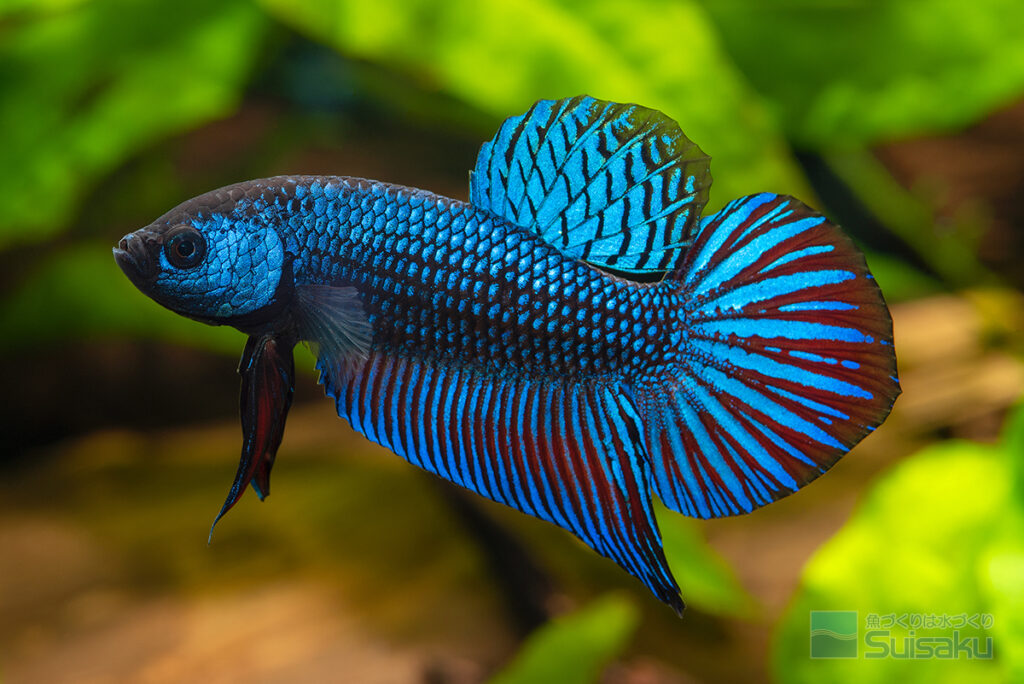
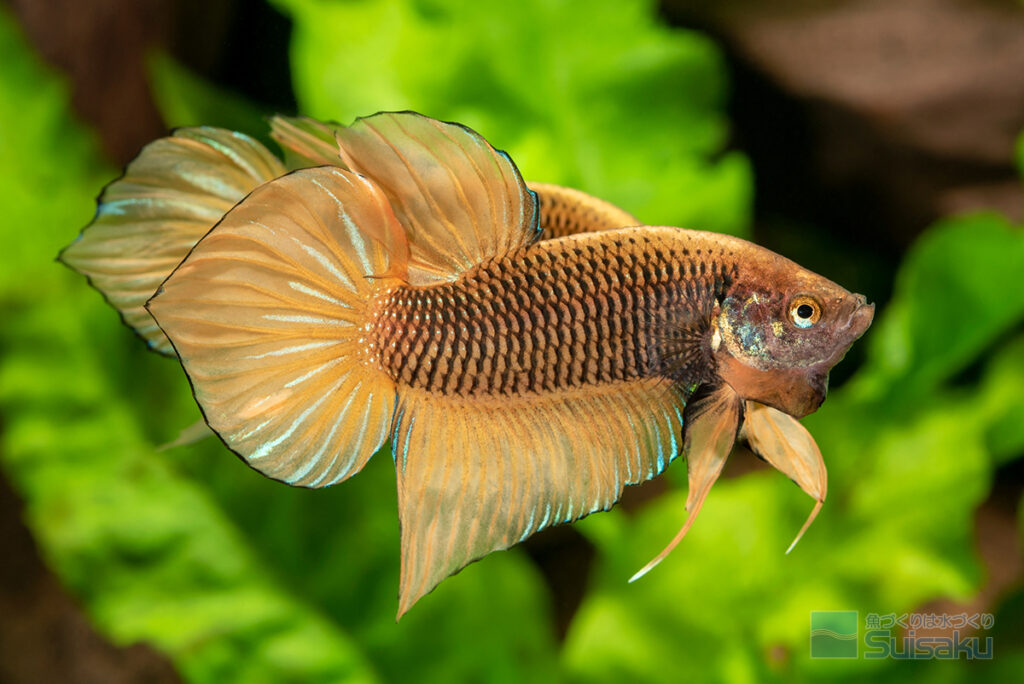
In terms of color variations, the Inveris Silver introduced at the beginning is also quite interesting. Looking at the evolution of improvements to Inverith, it all started with Metallica released in the 1980s, but since then there have been no notable productions (although improvements may have continued quietly), and finally in 2018. It became noticeable around Inveris Green (green body) and Blue (blue body). If you look at the history of fish, it is quite interesting, and you will be impressed by the variety of patterns that can be created by combining the colors of the body and fins. The oranges released in 2020 are also quite beautiful, and you could create an entire content just with the improved varieties of Inveris. I would like to summarize it if I have a chance.
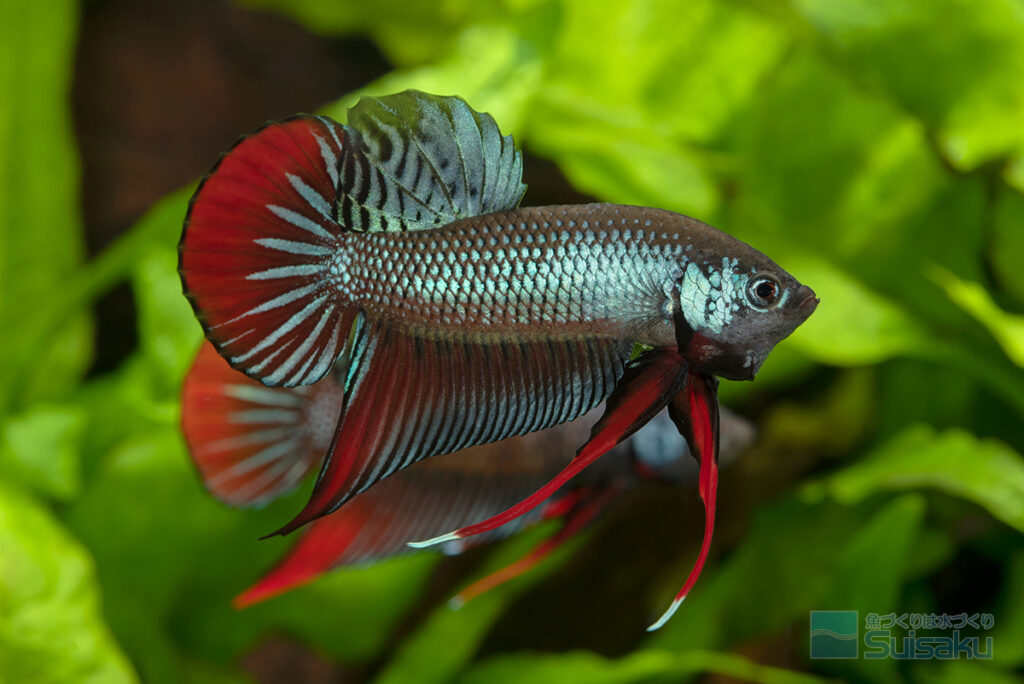
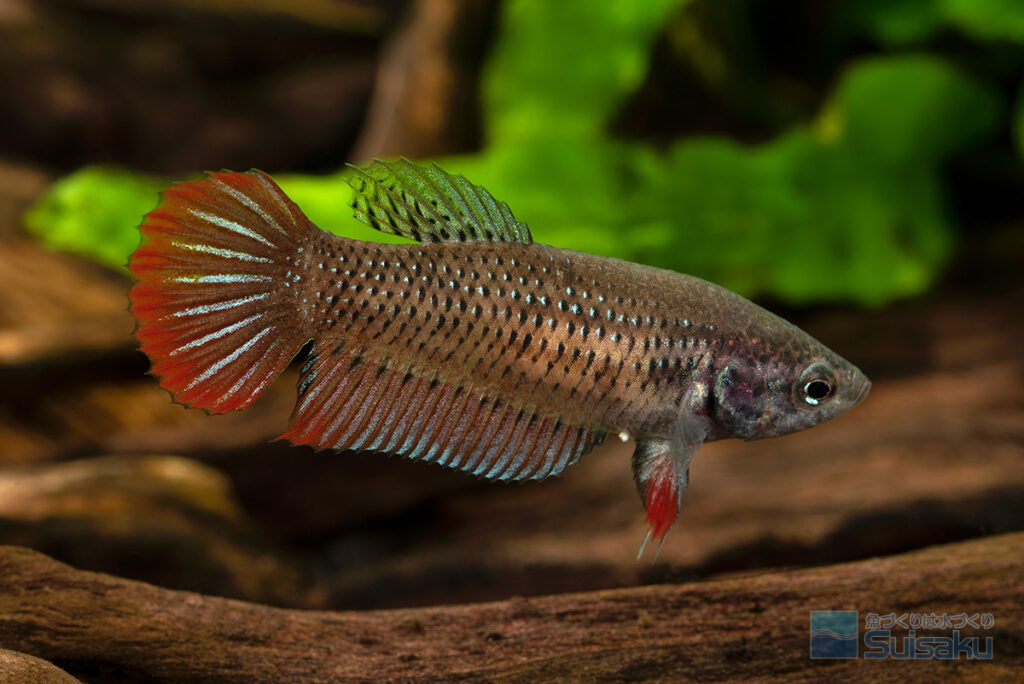
History of improved varieties of Inveris

Let's introduce some other attractive individuals. Popular alien copper. Compared to the flashy blues and greens, this color is more subdued and stands out more. Interesting fish have also been announced. Smaragdina Giant. It was mentioned that it would be larger than the general Smaragdina, but it wasn't that huge when I got it, and compared to the Mahachaiensis Giant released in 2020, it lacks an impact. However, its main characteristics are its sturdy body with a thick tail tube, and its tail fin, which forms a spade tail. It is said that the blood of Smaragdina from Buriram is used, and I feel that its characteristics are well expressed.
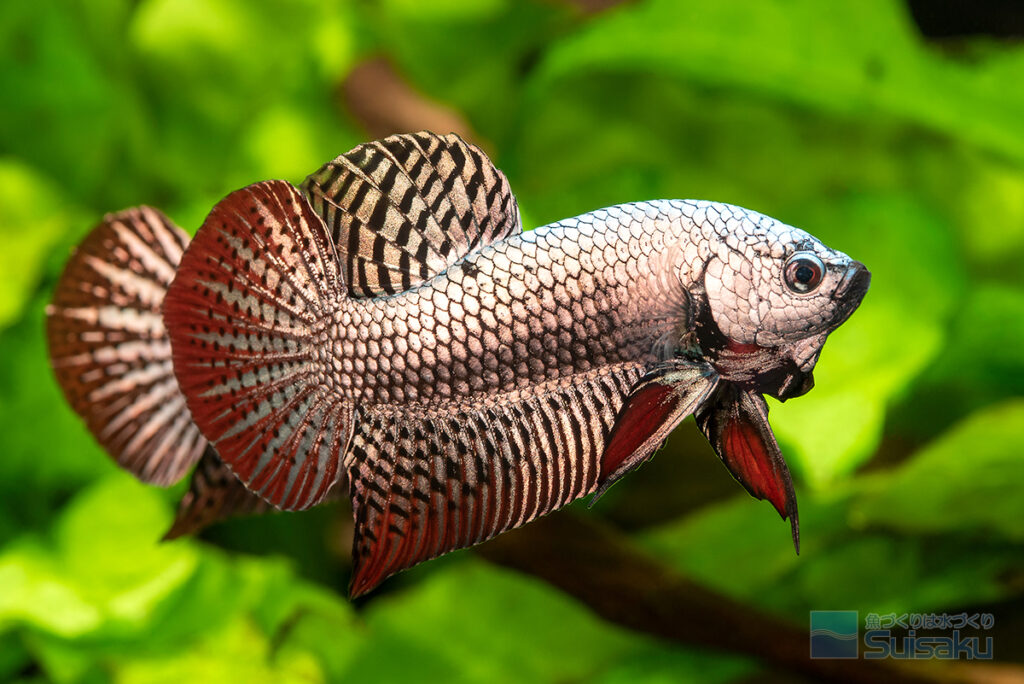
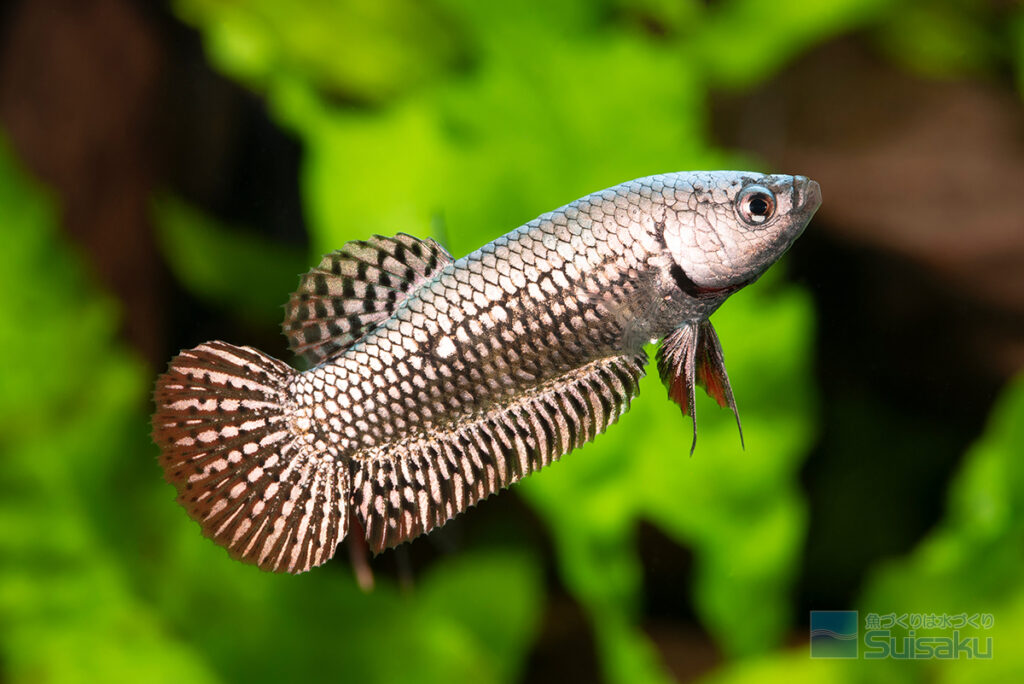
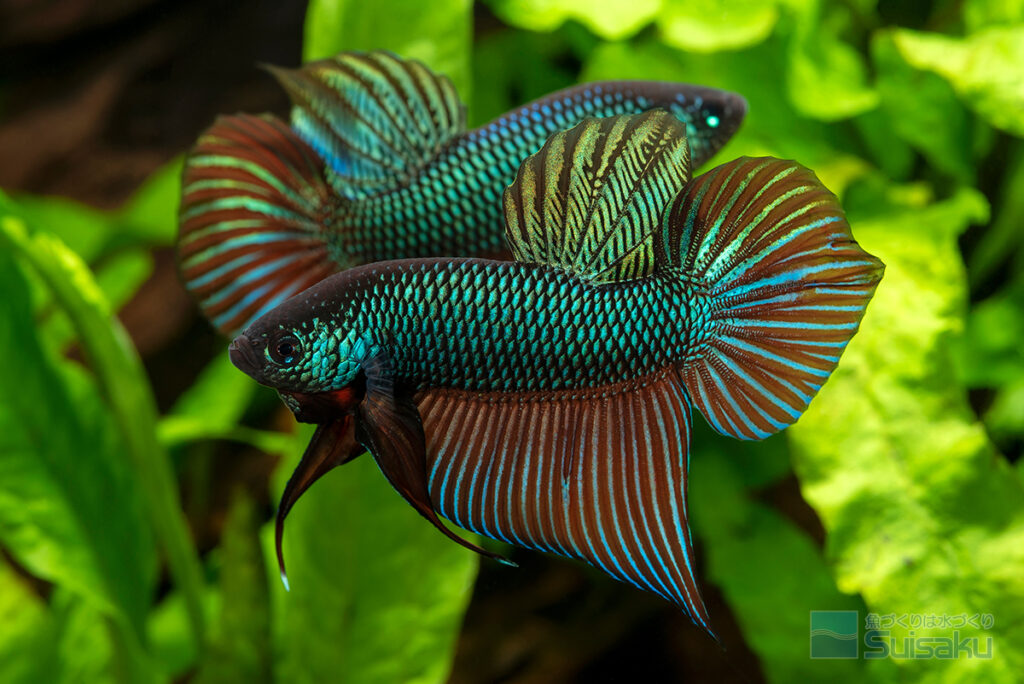
I also found two very interesting individuals, so I'll post them here. Both have a strong red color with a spade tail and a blue color, but it is completely unknown which species is the original parent and how the breeding happened. This may be a prototype fish for further improvement. Judging from the color of the gill lids, it looks like it has Inveris blood in it, but it may also be influenced by Splendens, which becomes a spade tail. It would be fun if we could create more beautiful wild crosses from fish like this. In the breeding part, this red type and female Smaragdina Giant are used as breeding examples. I'm thinking of breeding them to see what happens, so if I can keep a record of what happens after that, I'll introduce them here.
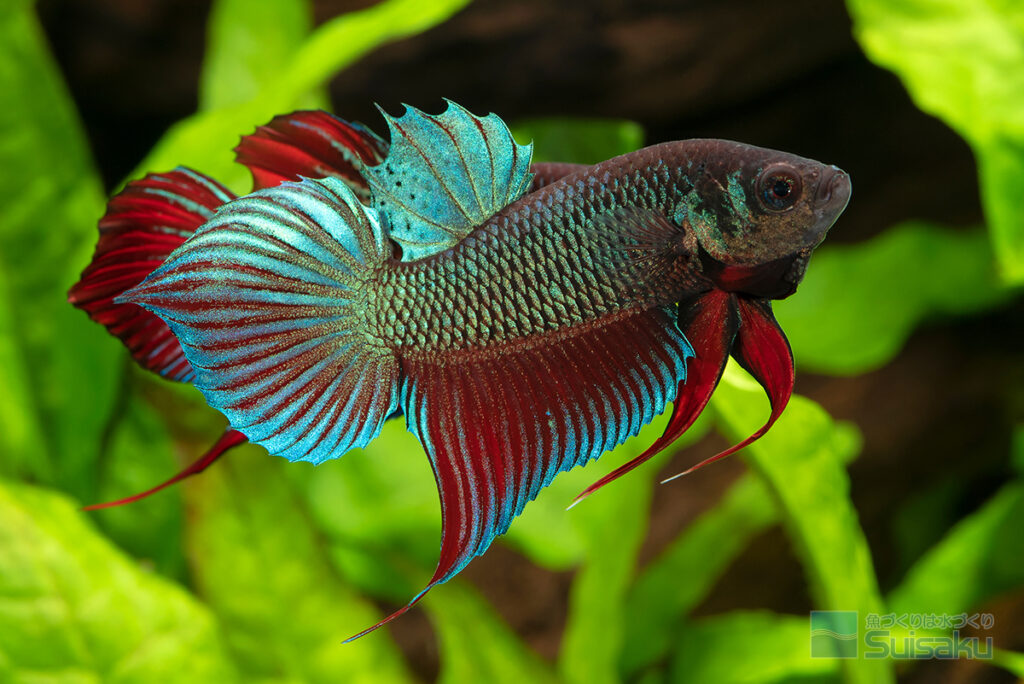
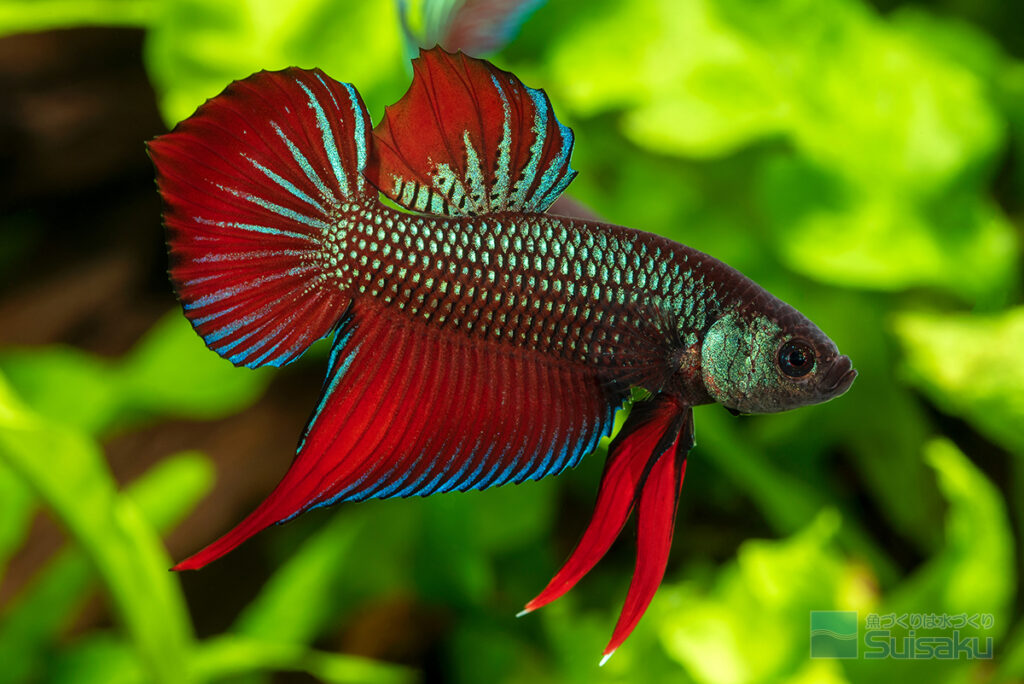
Key points of breeding
If you're an aquarist, you've probably heard that betta fish can be kept in small containers, such as bottles. However, strictly speaking, it is correct to say that they can be kept in a small container, and it is better to have a larger container. In other words, if you keep them in an aquarium with a filter like regular tropical fish, you will have fewer troubles and will be able to keep them in good condition. However, there are many different types of betta fish, and they are so diverse that you will want to collect several types. These fish can be raised without any problems in a small container if you keep a few points in mind, so we recommend that you try keeping multiple betta fish at the same time. So, here we will explain how to keep a wild cross using a small case.
◆Example of breeding wild cross
~Enjoy breeding and collecting at the same time~
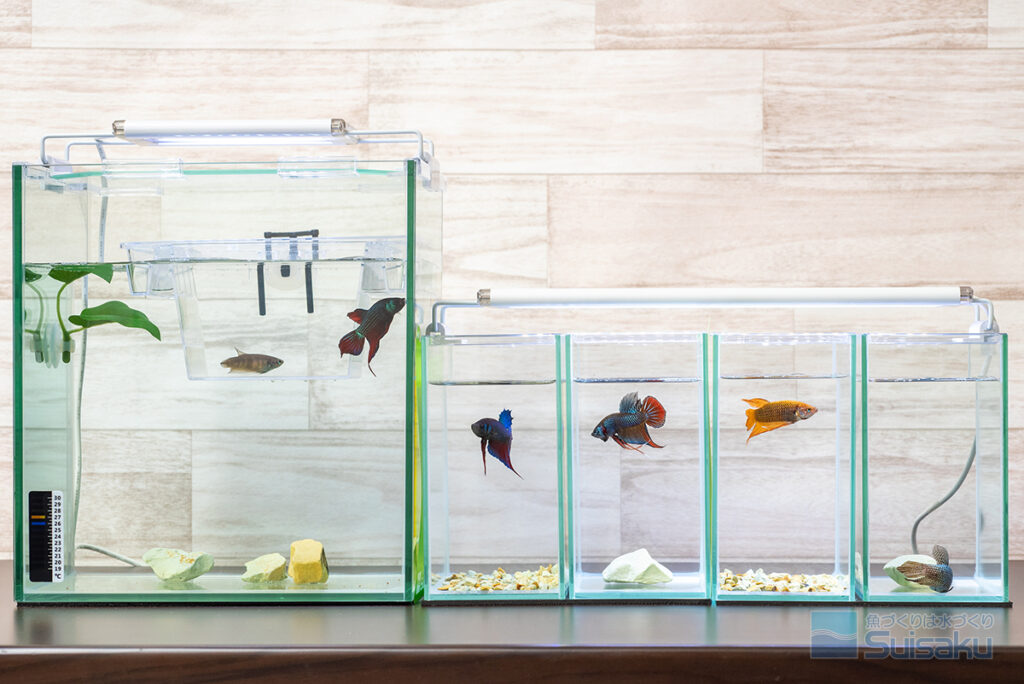
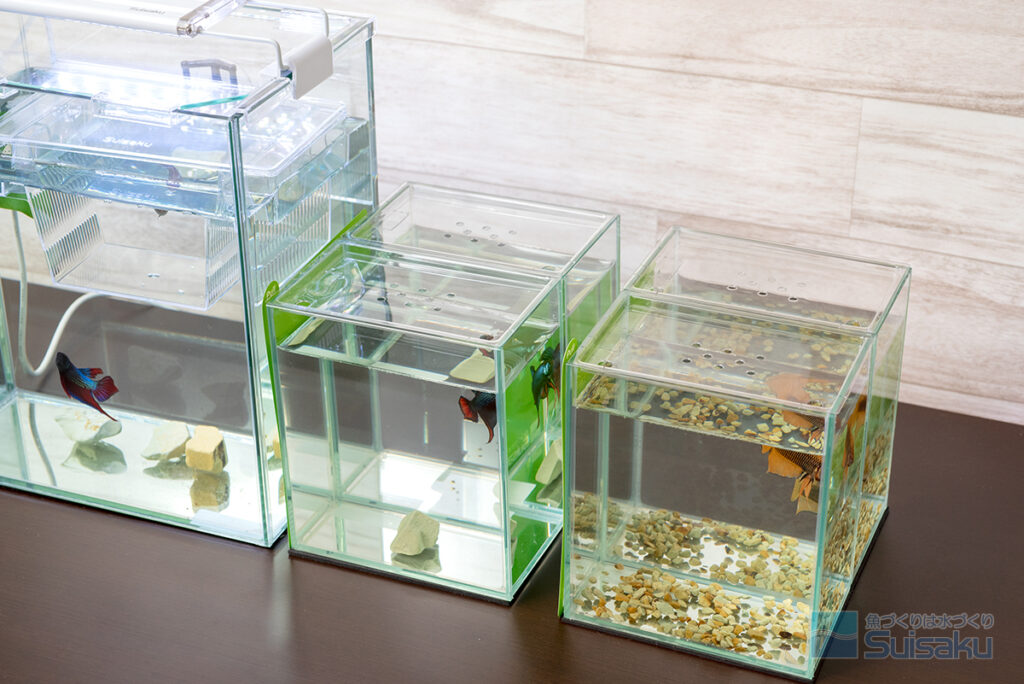
■Breeding DATA■
Breeding tank: width 230 x depth 150 x height 250mm/approx. 7.3L
Collection case: width 130 x depth 80 x height 150mm/approx. 1.3L
Filter: None
Filter media: Betta clean zeolite small grains 200ml, Betta clean zeolite large grains 200ml
Bottom sand: None
illumination:light up 150 white,light up 400 white
Dividers between cases:solid blind card
Water temperature: 26-28℃
Bait: Betta special floating food twice a day
Breeding organisms: Wild cross varieties
*The breeding tank has “Glass garden N230"use
*The collection case has “Showbetta Collection Case M"use
*The water temperature gauge isPaste balance M"use
●Betta breeding, basic basics
・Male betta fish should be kept alone.
・It is not allowed to be kept in a closed environment as it breathes air.
Some people may not know much about betta fish, so let's first understand the basics of breeding them. Betta fish are also called fighting fish, and males fight fiercely with each other. Sometimes the fights are so fierce that the opponent even dies. Therefore, it is best to keep males alone and not together. Females also fight with each other, but they are not as violent as males, and multiples can be kept in an aquarium with a width of about 1cm. However, it is recommended that females be kept alone as they tend to nibble each other's fins, which is a negative aspect of ornamentation.
Betta fish also have a respiratory support organ called the labyrinth organ, and in addition to gill breathing underwater, they also breathe air by sucking air directly from the water surface. This is a special ability acquired by the original betta fish by living in environments such as wetlands with low amounts of dissolved oxygen. However, if they cannot breathe air, they will die, so it is not recommended to keep them in a closed container.
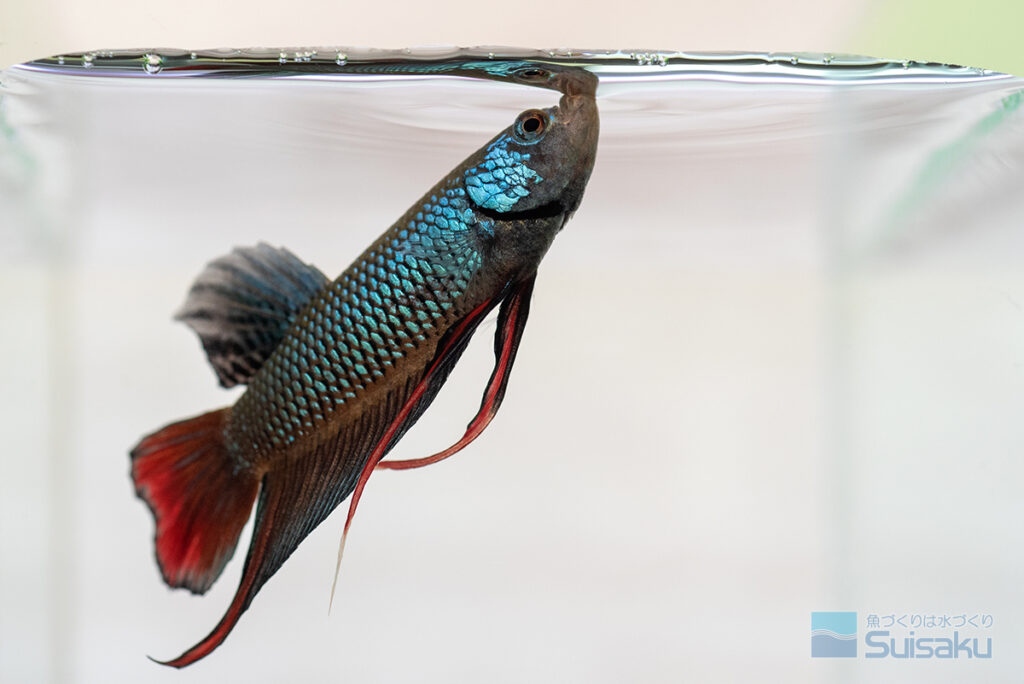
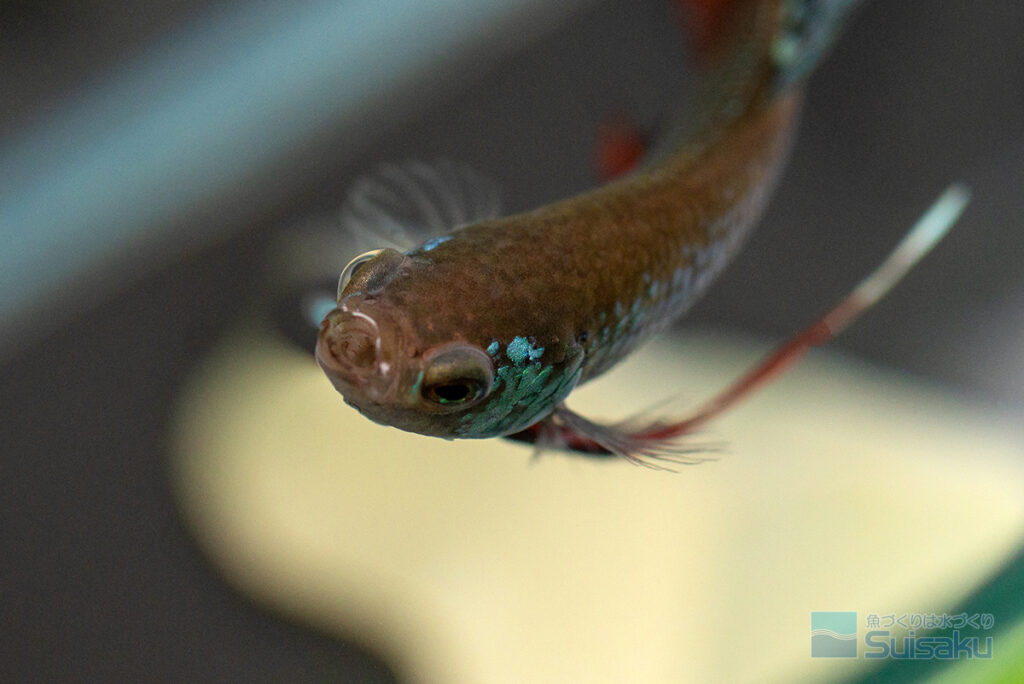
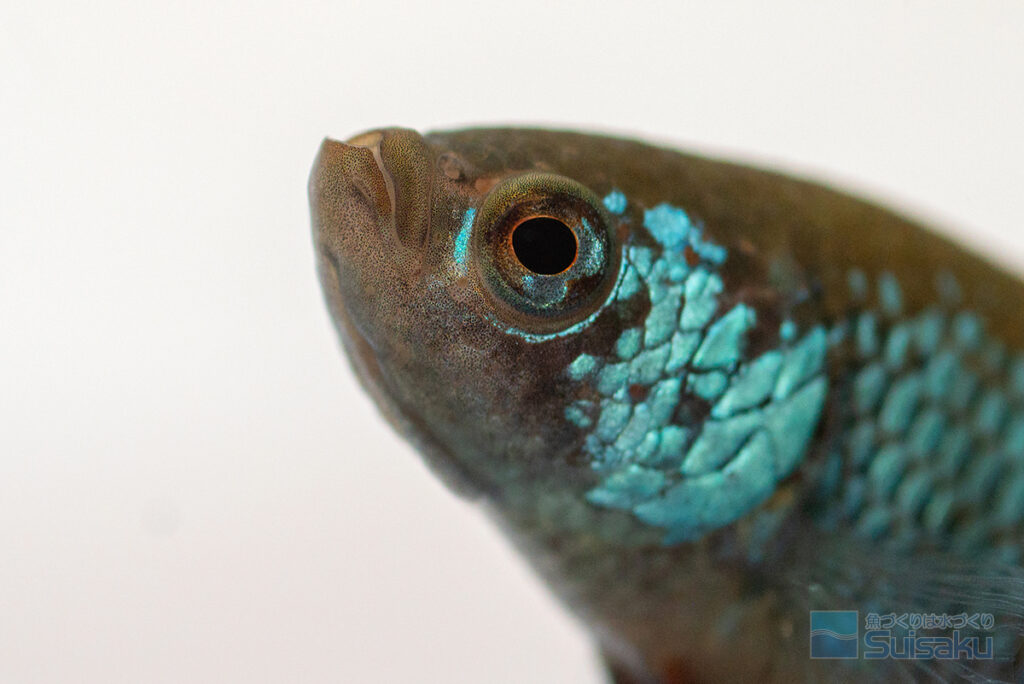
●Distribution and acquisition
・Wild Cross has a small distribution volume.
・Easy to obtain at stores that are strong against solids
It's a bit disappointing that Wild Cross is not a betta that can be seen everywhere now. However, if you are a shop that is strong in Betta, they will occasionally receive stock, so if you check the stock information on a daily basis, you should be able to get it. Since Betta is still in limited distribution, it might be a good idea to make friends with the staff at the shop and ask them to stock it.
●How to select individuals
・Choose healthy individuals that are energetic and not underweight.
・The male is an oraora type individual who gets angry easily◎
It is recommended to choose a lively individual with a good color and luster on the body surface, as well as one that gets angry easily. If you are purchasing at a shop, ask the staff to remove the partitions between the cases. If it is an individual that gets angry easily and spreads its fins, there will be no problem. It is best to avoid individuals that are dazed on the bottom or near the water surface, individuals that do not spread their fins easily, and individuals that are thin. Individuals of the oraora type that are quick to fight are suitable for purchase. If you want to aim to spawn eggs right away, it is better to choose a female with a large abdomen and a well-developed ovary. We recommend individuals with a glossy body surface that swims with their fins spread out.
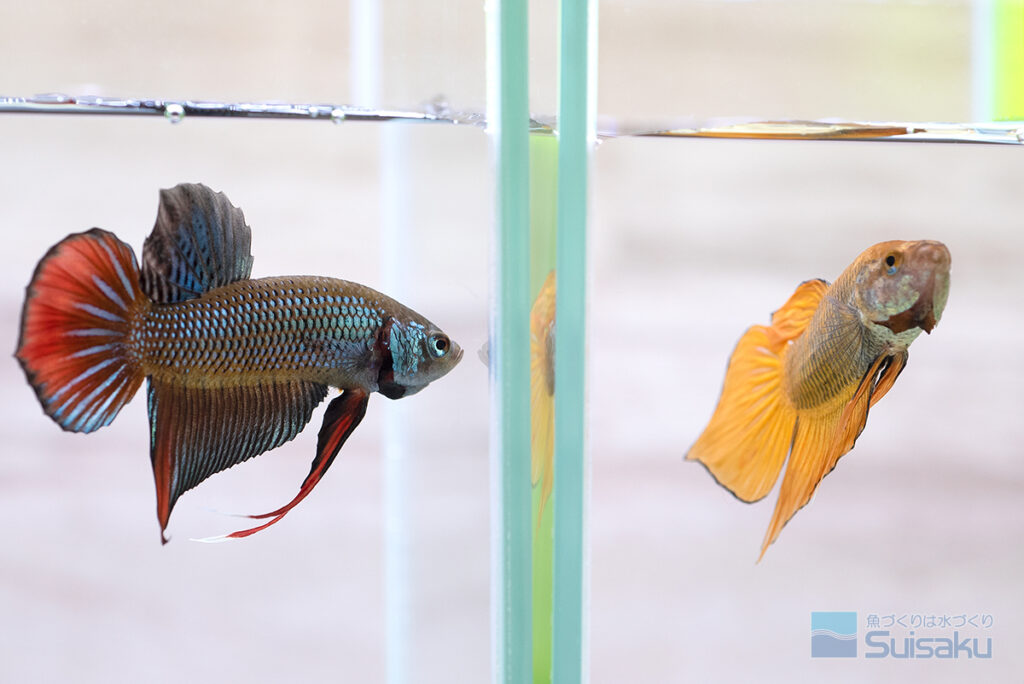
● Breeding container
・A small case is convenient if you collect multiple varieties.
・If you are aiming for breeding, we recommend an aquarium with plenty of water.
If you want to collect multiple fish or keep them in a small space, we recommend a small container without a filter. I think it's easy to manage if the amount of water is about 1L. In this breeding example,Showbetta Collection Case M", but if you fill the case with 7-8% of the water, it will be about 1L.
Considering the ease of pairing and raising young fish, we recommend an aquarium rather than a small case for breeding containers. This time we are using an aquarium with dimensions of 23 cm wide x 15 cm deep x 25 cm high.
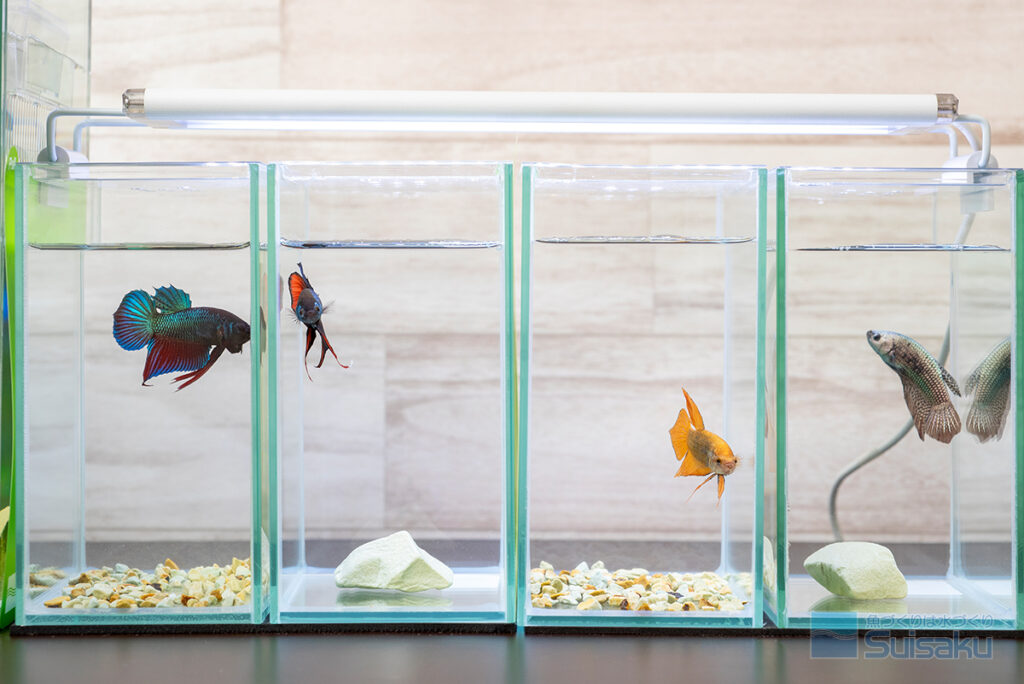
-Card for blindfolding between containers
・Usually insert a card between containers to reduce stress
When a betta fish spots another individual, it will spread its gill covers and fins to intimidate the other individual. Males in particular get stressed if their partner is always in their line of sight, so it's a good idea to put a card or something between them so they can't see each other normally. This card can be of any kind, but it is convenient to use one made of water-resistant material. Here we have a dedicatedsolid blind card'' is made of synthetic paper called Yupo, so it's water resistant and comes with a knob, so it's easy to use. There is no problem if the male can see the female, but if the female does not like it, please blindfold her with a card.
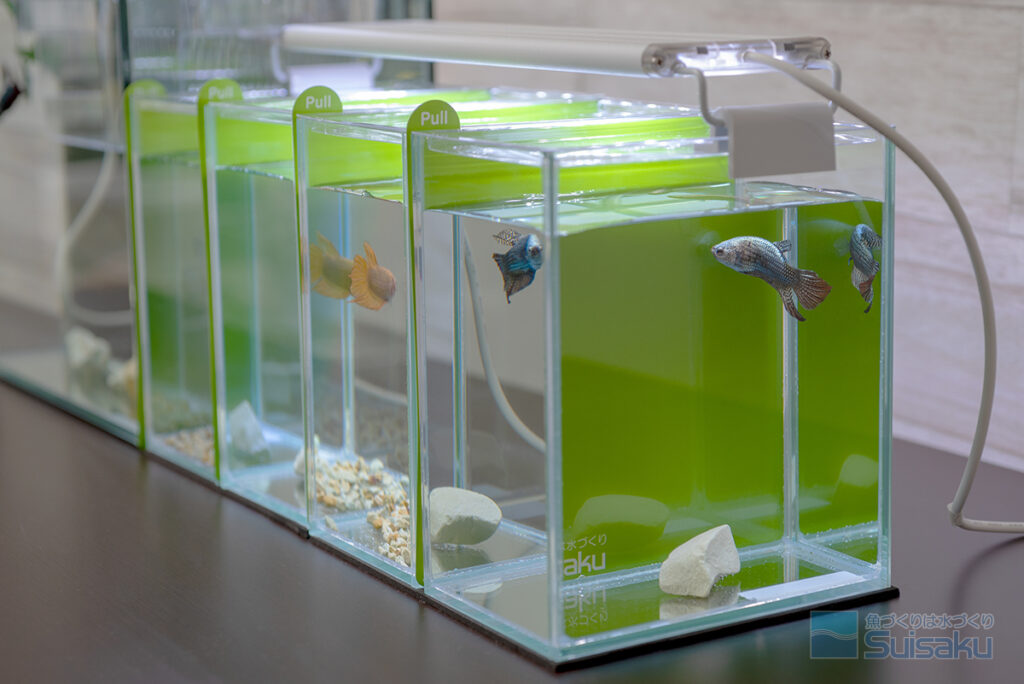
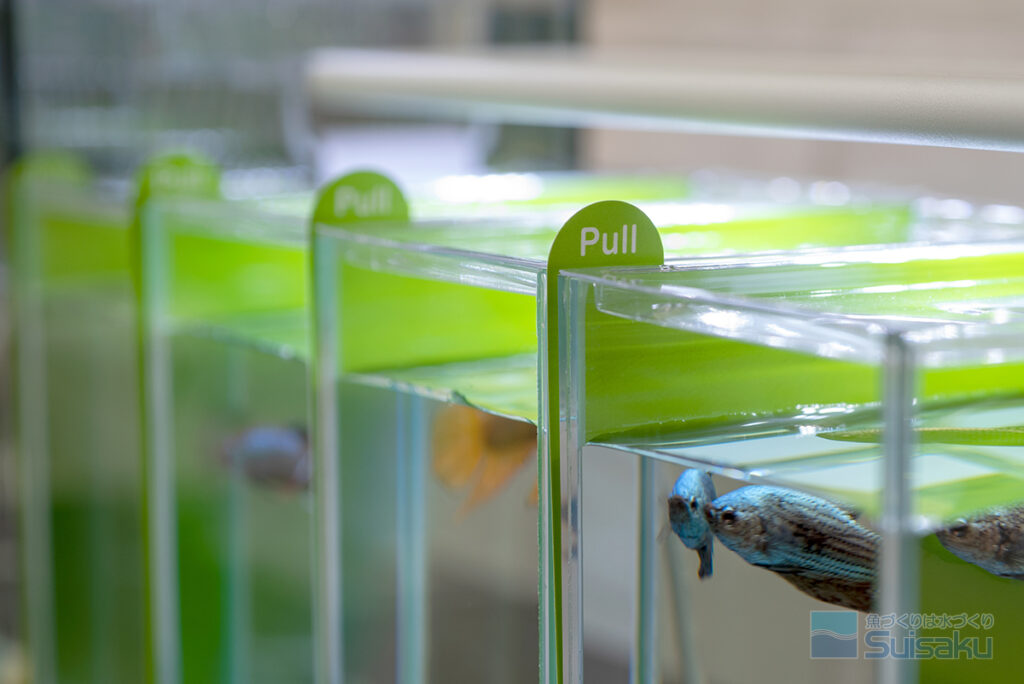
●Lid
・Wild Cross has strong jumping power, so be careful
・Be sure to cover the case when breeding.
Improved betta fish with large fins, such as half-moo fish, rarely jump, but wild crosses often jump out of the case, so be careful. I have had the experience of drying out a betta fish that I had carefully raised, and it was very sad. Therefore, be sure to cover the case. You can make your own, but it's best if you have a special one. Here, we are using the included special lid for the aquarium, and the separately sold "Show Betta Collection Case M Special Lid" for the collection case.
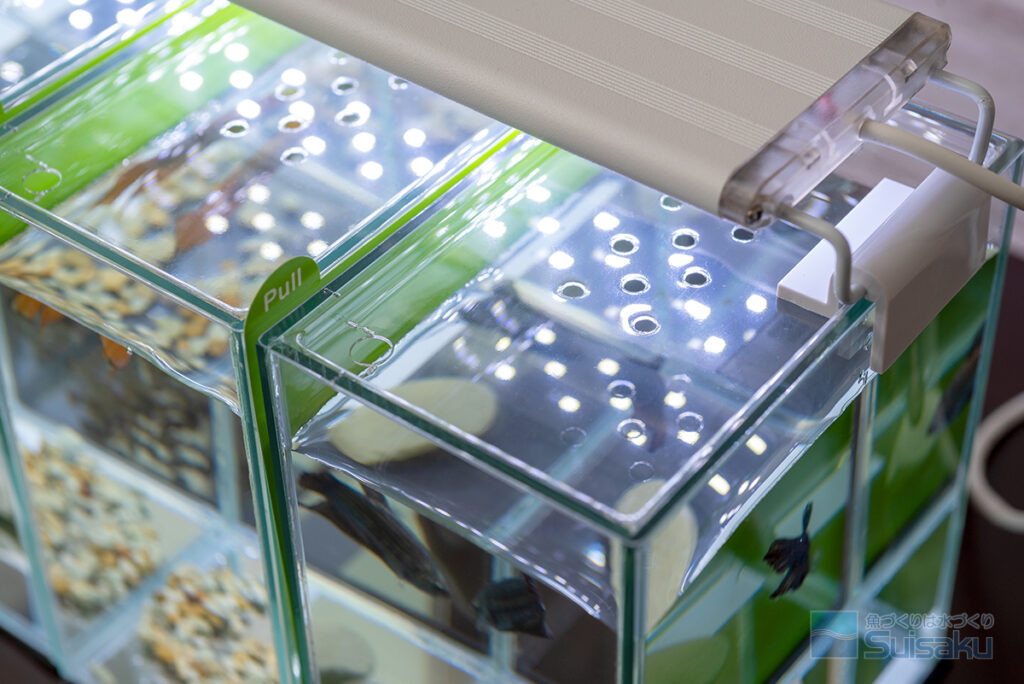
●Filter
・No filter required for small cases
When breeding in a small case, it is important to maintain water quality by frequently changing the water without installing a filter. If you have a container with a certain amount of water, like the breeding tank I used this time, I think it would be a good idea to install a small filter and raise it. If you can maintain good water quality with a filter, you can reduce the need for water changes. If you are busy and don't have time to change the water, you may want to set up a filter when raising your pet. However, improved bettas do not like strong water currents, so if you use an underwater filter, make sure to weaken the water flow, or use an air pump to operate it.Suisaku Eight SeriesWe recommend using a drop-in filter such as ``.
● Breeding water
・Can be used with tap water that has neutralized the chlorine in the tap water
You can raise them without any problems if you neutralize the chlorine in the tap water. It's fine if you can maintain the pH value between 6.0 and 7.5, but there's no need to be nervous; rather, try to change the water frequently and keep it in fresh water. Be careful, as droppings and uneaten food can easily stain the water in small containers, and the pH value may drop too much, causing problems.
●Let's use Betta's water making items
・We recommend zeolite, which absorbs ammonia, and magnolia items, which have a bactericidal effect.
Zeolite, which is widely used as a filter material for ornamental fish, adsorbs toxic ammonia, so it is also recommended for breeding betta fish without using a filter. In writing this article,Betta clean zeoliteI tried using it and found that the water was much clearer than I expected and it worked really well. When you keep multiple betta fish, you end up with a container that gets dirty easily and makes it difficult to maintain stable water quality, so you might want to try using zeolite in those cases as well.
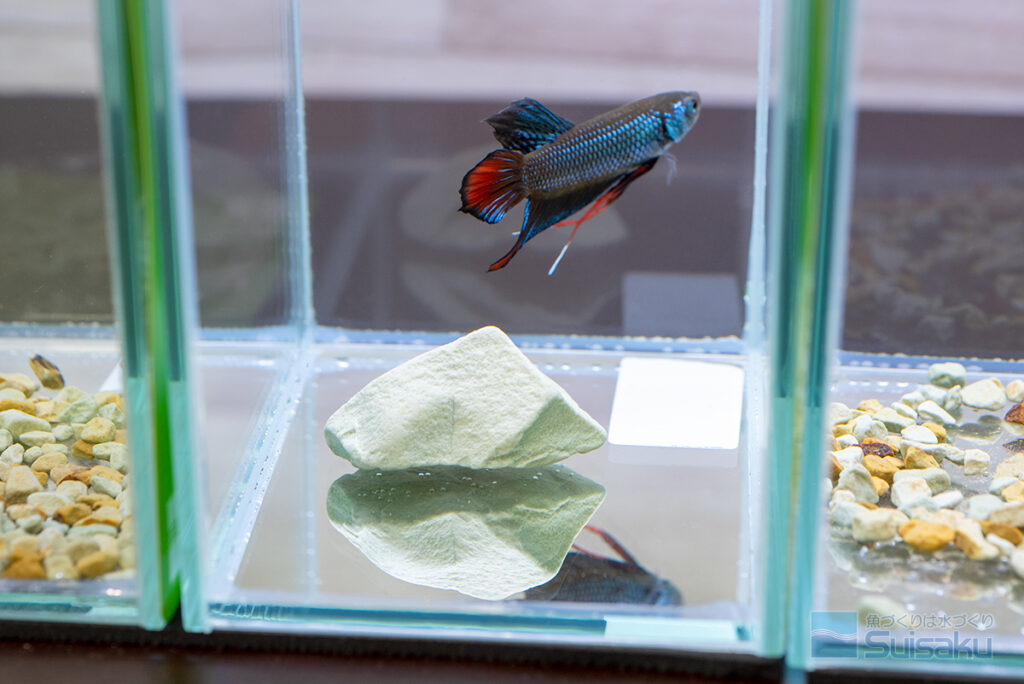
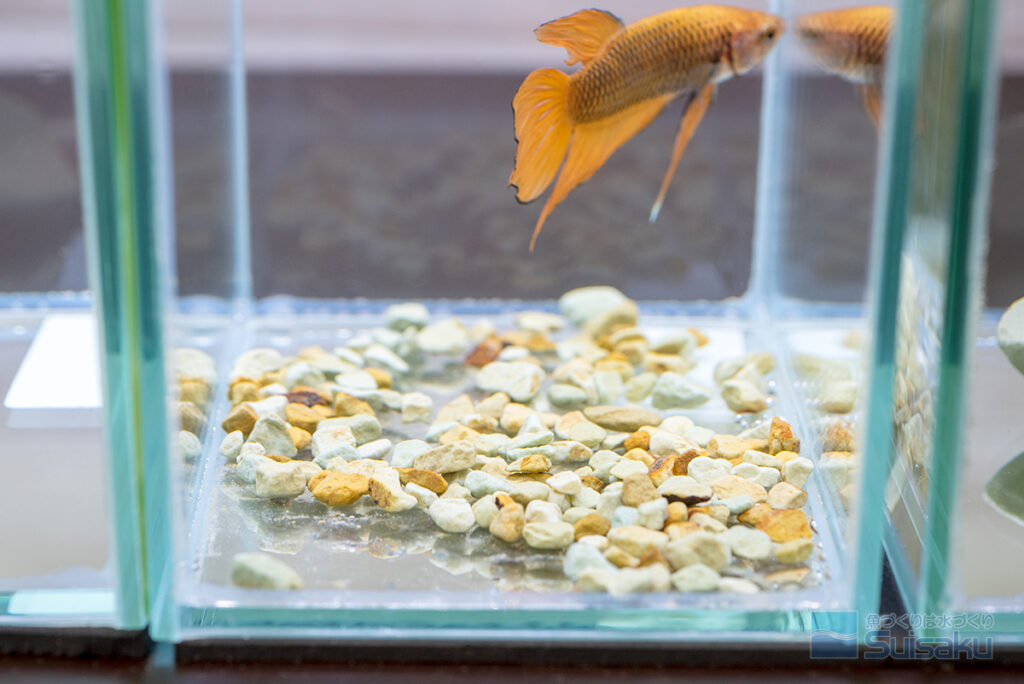
Also"betta leaf extract pack” is also a recommended item for stabilizing water quality. It is packed with domestically produced magnolia leaves and zeolite, which have the effect of suppressing germs, and when placed in a container, the breeding water turns brown and maintains the water that bettas prefer. I also tried using this, and it's good for betta fish. You can put the pack directly into the breeding container and raise it, or it may be helpful to maintain water quality by adding a small amount of water made by putting the pack into a separate container when changing the water. When used during breeding, bettas may become more motivated, so it may be a good idea to try using it on individuals who don't show any breeding behavior.

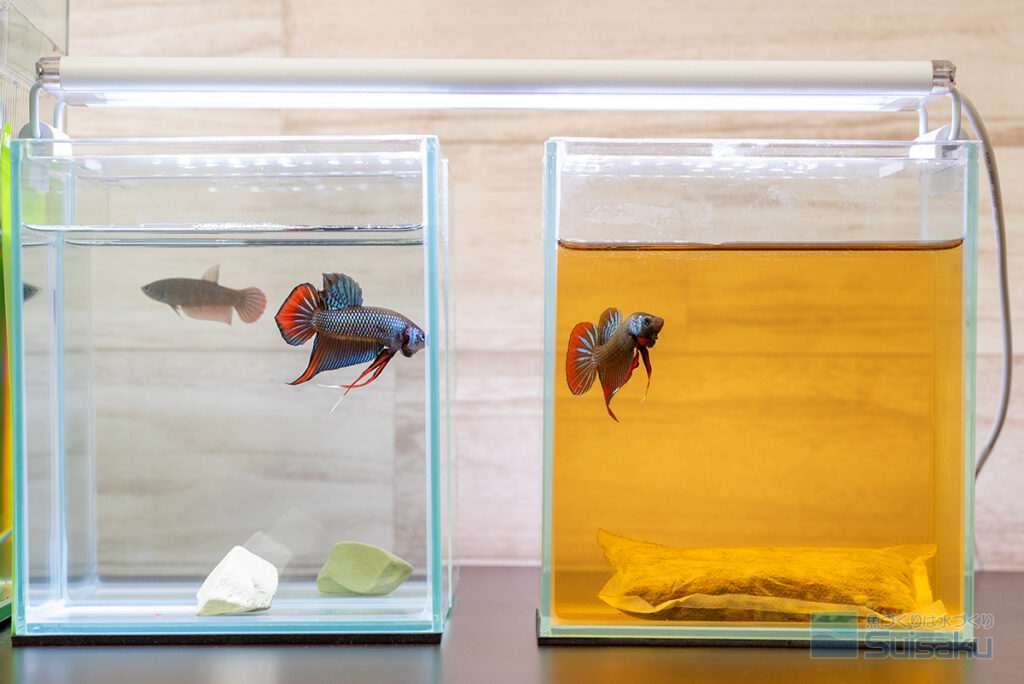
●Water temperature
・Maintain 25-28℃
・Maintain an appropriate temperature in winter with thermal equipment
Water temperatures around 30°C are fine for wild crosses, but it is generally best to keep it at 25-28°C. If the water temperature is high, males will build bubble nests more often, so if you are aiming for breeding, the trick is to keep it high.
Bettas can be kept at temperatures above 20 degrees Celsius, but keeping them at low water temperatures can be difficult to manage, as you have to feed them less food. Therefore, in order to maintain your health in the winter, use air conditioners and heating devices to maintain the appropriate temperature. You can keep multiple small cases warm at once.aqua panel heaterWe also recommend using a heating device that is convenient for betta breeding.
●Bait
・Feed enough food to fill your stomach
・Special feed for bettas is recommended.
・Remove leftover food as soon as possible
As someone who has kept bettas for a long time, I am surprised by the high quality of recent betta feeds. It is said that high-protein foods are suitable for betta food, but special feeds have been released that are not only high in protein, but are also designed to suppress the betta's intestinal environment and water pollution. You can keep them in good condition with just these feeds. Since I started using special feed, the opportunities to use live feed such as frozen feed have decreased considerably, but I think it can be said that the quality is that much higher. Moreover, it is easy to feed because it floats so that betta fish can easily eat it. it's recommended.
The amount of food fed is enough to make the betta's belly plump. The amount of feeding is also listed on the package, so please refer to it. In my case, I don't just eat the same amount every time, but I adjust it depending on the individual while watching how they eat. Just like humans, bettas don't always eat a lot. If the fish are not eating well, feed less, and in some cases, there may be days when you don't feed them to stimulate their appetite.
Feeding is a valuable time to check your betta's health, as individuals that are not in good health may eat less or stop eating. Make sure to closely monitor your eating habits. How to deal with a betta that is out of condition is explained in ``Betta Health Management and Disease Prevention''. Any uneaten food can contaminate the water, so be sure to remove it as soon as possible.
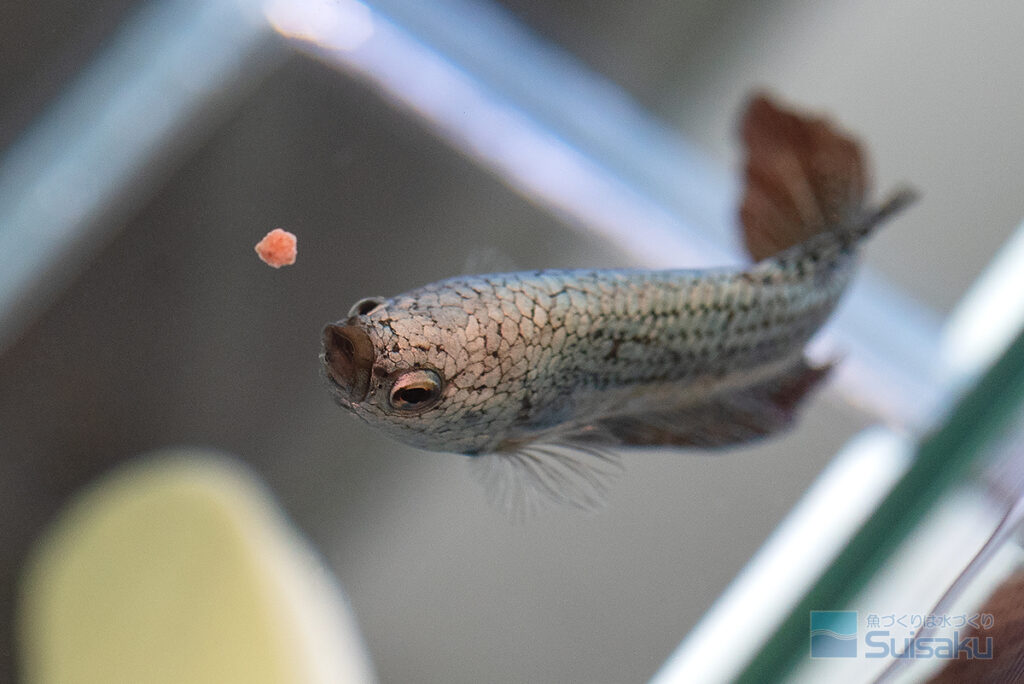
●Lighting
・Admire the beautiful body color when lit up
It is not necessary to turn on the lights when the keeper is not present, as leaving them on for long periods of time can lead to the growth of moss (algae), but we recommend using lights, as it allows you to see their beautiful appearance. It is also useful to have a light when observing your betta fish during feeding and water changes. Lighting is also essential when raising aquatic plants.
●Daily water quality management and environmental maintenance
・Maintain water quality by removing feces and replacing water
・It is convenient to use a large dropper to remove feces.
- Replace the water with chlorine-neutralized tap water or pumped water.
When breeding in a small case without using a filter, removing droppings and replacing water are important points to maintain water quality. You can remove droppings in the morning or at night, but if possible, do it every day to maintain good water quality for your betta fish. If left unattended, droppings often contaminate the water and cause disease outbreaks, so it is best to remove them as soon as possible. A betta fish may look fine even if its droppings are left for a long time, but the water may become extremely acidic, causing damage to its fins and reducing its ornamental value. After all, it is best to take out the droppings as soon as possible without leaving them unattended. You should be able to maintain a comfortable environment by removing feces and replacing the water with fresh water at the same time.
A large pipette or dropper is useful for removing droppings. "multi dropperWe recommend a dropper for aquariums as they are easy to use.
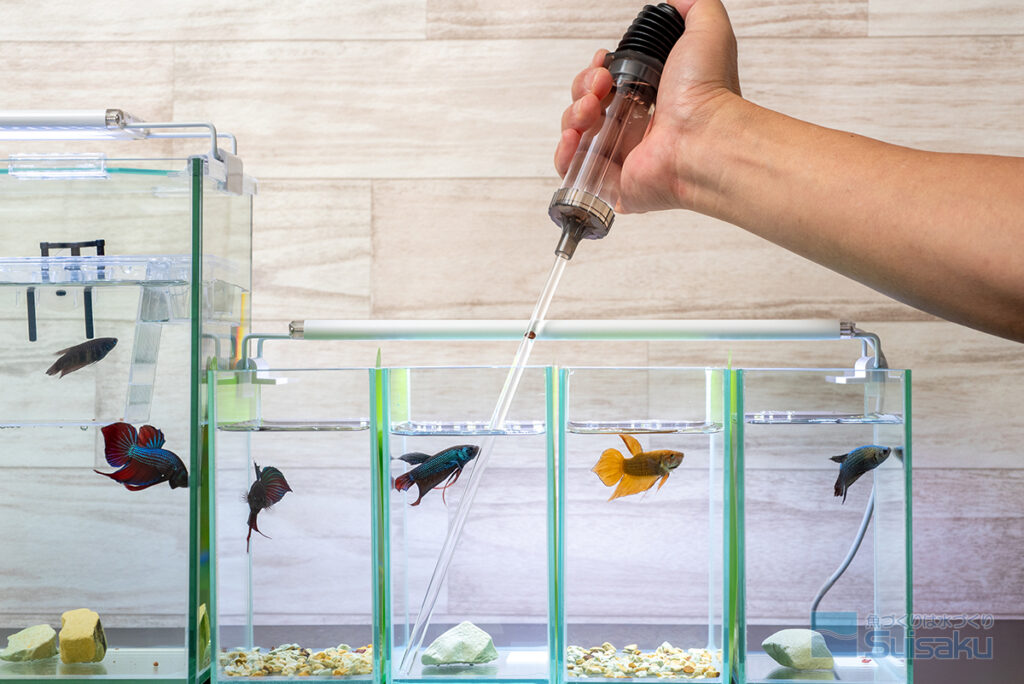
You can use chlorine-neutralized tap water for water changes, but I use tap water in a plastic bottle and let it sit overnight. Try doing it in a way that makes it easier for you. In my case, I change about 1 to 2cc of water almost every day for a 100 to 200L container. It's about 1/10 of the total amount of water. If you can't do daily water changes, try developing your own pattern, such as once every three days. There is no problem even if you change about 3/1 to 1/3 of the total amount of water. If you want to change a lot of water, use an aquarium hose.quick water change pump” is convenient to use.
Also, if your pet is kept in the same container for a long period of time, dirt will become noticeable, and moss and dirt may adhere to the glass surface. In this case, you can wash the case and completely change the water. At this time, if you stock up on empty cases, you can simply move the fish there, making the process easier. If you plan on doing a complete water change, you can fill an empty case with water the day before to move the fish smoothly. Therefore, when breeding multiple betta fish, it is recommended to stock up on several empty cases.
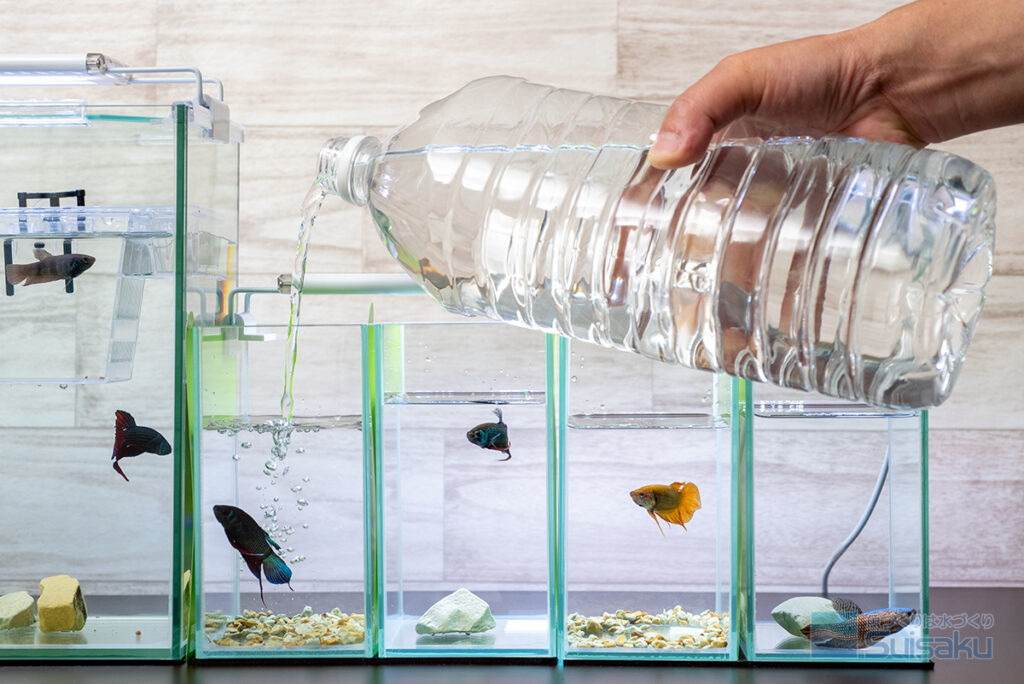
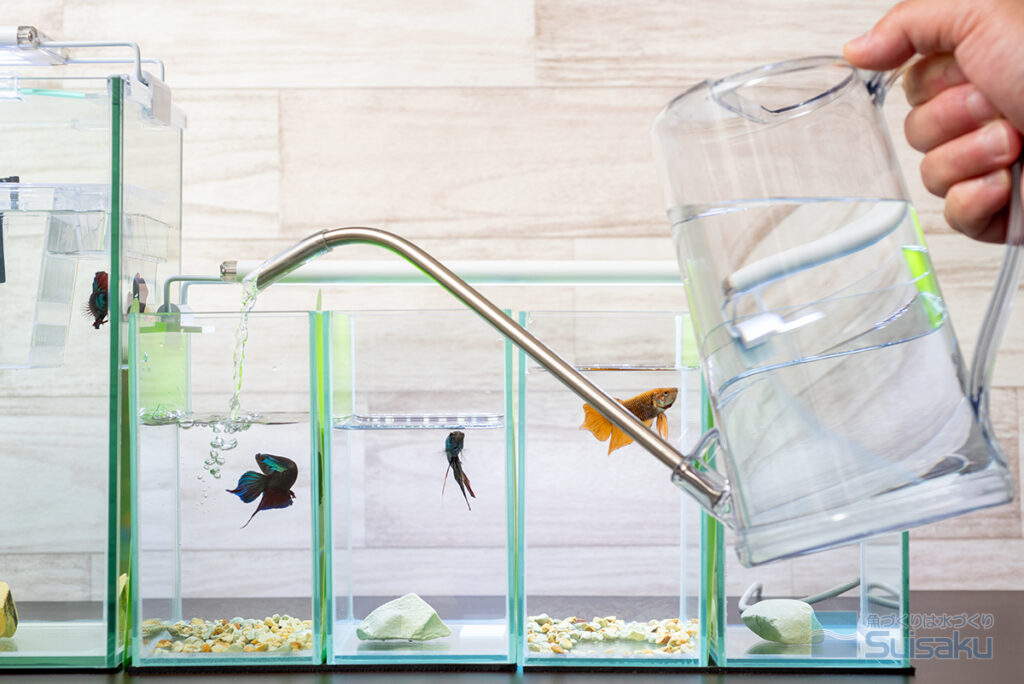
●Recommendation of flaring
・Grow betta fish beautifully with flaring training
・Stop training when you can't win or lose.
・If kept alone, use a mirror
We recommend flaring training when breeding betta fish. If you have multiple betta fish, try removing the blindfold cards between the cases. When a betta fish spots a mate, it spreads its gills and opens its fins to make itself appear larger and more intimidating. By flaring the fins, you can spread out the fins and maintain a beautiful figure. When you think about it, flaring training is like a basic stretching exercise. It is best to think that moderate exercise will help raise a healthy betta fish.
Flaring training is also a great viewing time. Raising while looking at beautiful solids. This is the real thrill of raising betta fish. If the training time is too long, it will put a strain on the betta, and he may lose his fighting spirit and stop flaring. The key is to stop the game without winning or losing. By doing so, they will believe that they are strong and will always show off their beautiful appearance in a relaxed state. It's a good idea to train for about 2 to 5 minutes, 1 to 3 times a day. By the way, if you only have one betta, or if you have multiple bettas but don't have a case nearby, you can do flaring training by showing yourself using a hand mirror. Please try it out.
●Use of useful items
Now that betta fish have become a popular tropical fish, a variety of useful products have been released specifically for them. I also tried using it and thought it was great.Betta's Good Night Leaf”. This is a well thought out product. Bettas often sleep on the bottom or near the surface of the water, but in the wild they are probably resting in places where they can hide, such as among the grass near the water's edge or under fallen leaves. When you install this product, it often rests on the leaves. The upper leaves may provide shade and calm down. OK.
Good night reefs can also be used as spawning beds for bubble nests made by bettas. If you place the upper leaves near the water surface, you can observe how bubbles accumulate on the underside of the leaves. It seems that each individual has a preference for where to make a bubble nest, so this is not always the case, but if there is no other material available for spawning, there is a high probability that they will make a bubble nest.
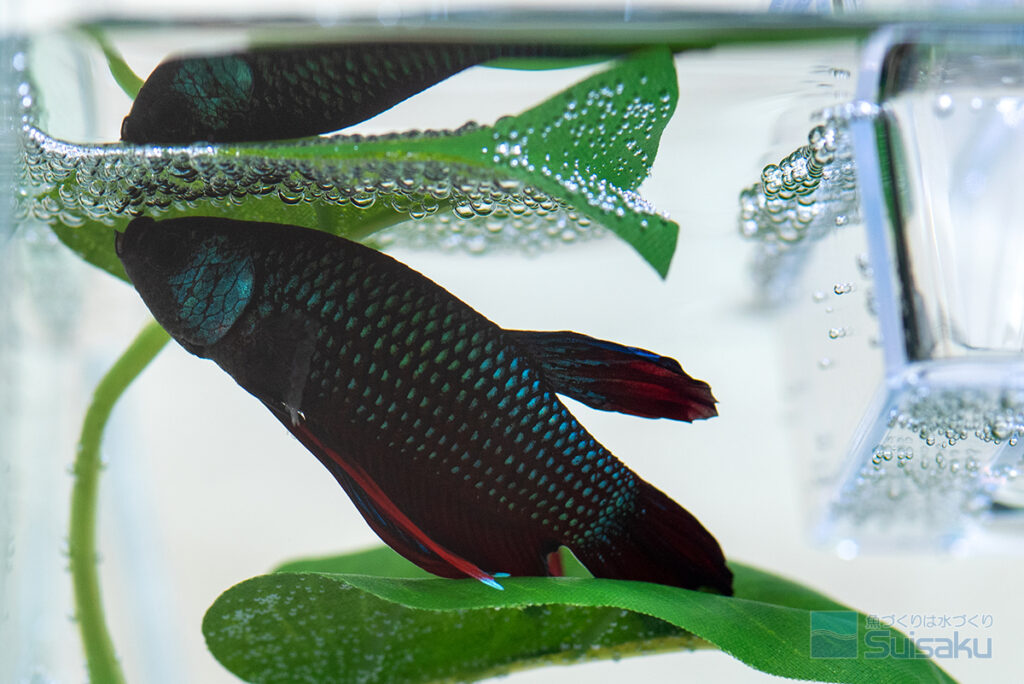
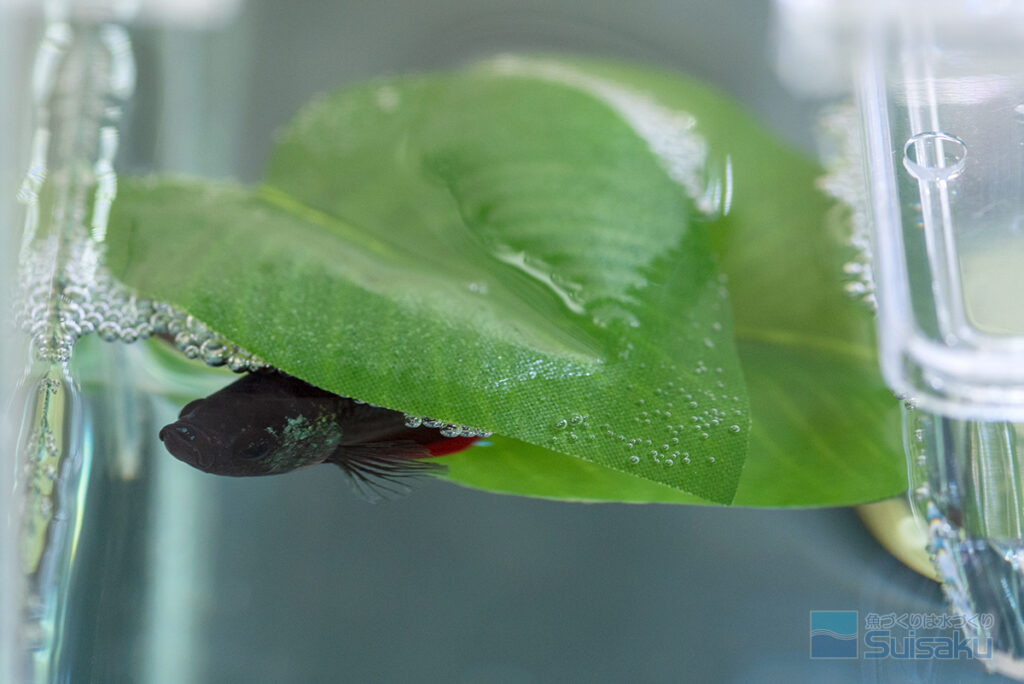
Health management starts with checking your feces.
・A healthy betta's droppings are solid and sausage-shaped.
- Observe the droppings every day to understand the health condition of the betta fish.
An effective way to check your betta's health is to check the shape of its droppings. By observing the droppings every day, you will be able to understand your betta's physical condition. A healthy betta's droppings are solid and firm. If you look closely, it actually looks like a long sausage that is connected and not separated. The color of the droppings depends on the color of the food, but most of them are brown to dark brown. Males have large bodies and eat a lot of food, so their droppings are large, while females are small. If they are solid and solid, they can be considered healthy.
On the other hand, if your betta fish is not in good health, the stool may be soft or the droppings may be mucus-like and easily soluble in water, so the droppings may not be noticeable. As you get used to it, you will be able to notice abnormalities in droppings quickly, so if you notice any abnormalities, refer to the next section and take immediate action.
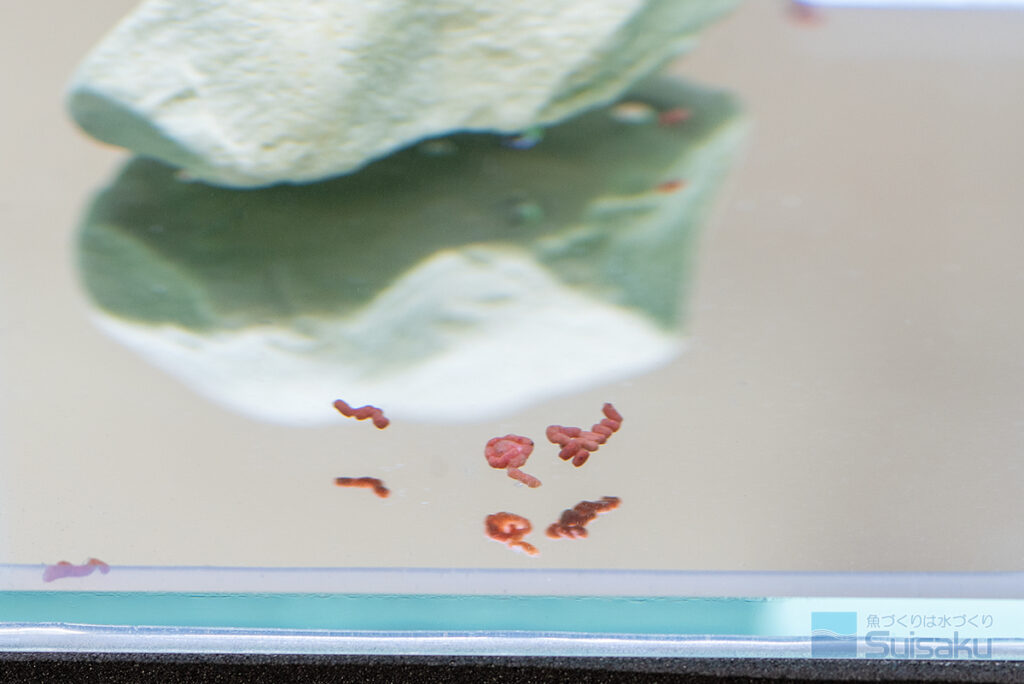
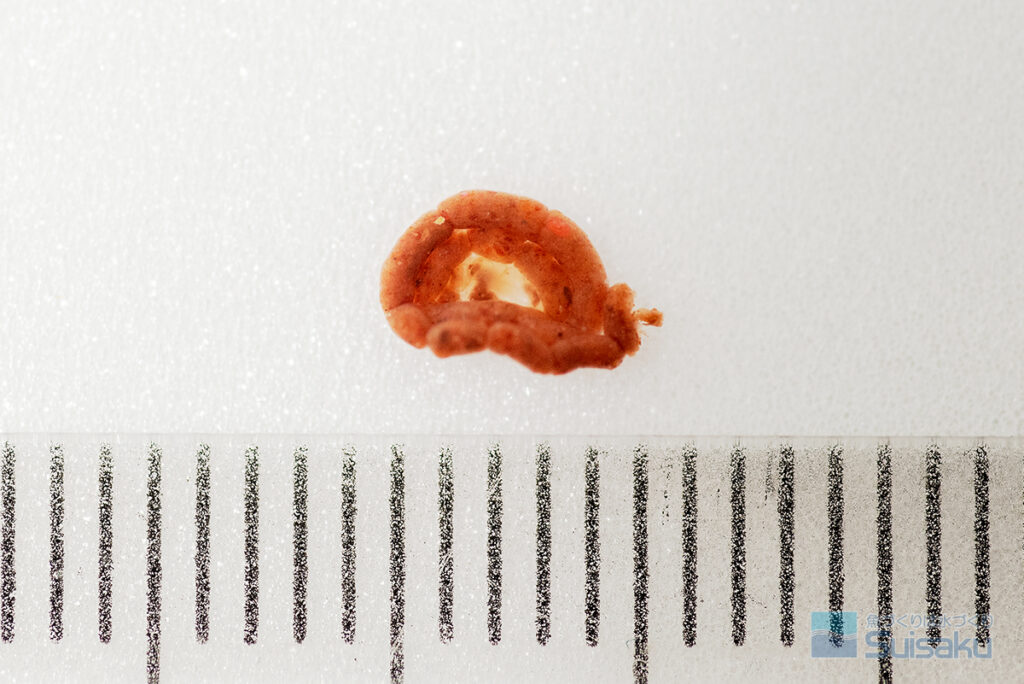
Betta health management and disease prevention
・If things get out of order, change the water and add salt as soon as possible.
With proper management, you can keep your betta fish healthy, but there are still a variety of factors that can cause your betta fish to become unwell. Therefore, it is important to know how to recover when you are not feeling well. First, let's list the signs when your betta fish is out of shape.
-Lack of appetite and difficulty eating food
・The condition of the feces is different from usual.
・The fins do not open well and often lie still on the bottom of the water.
- Does not respond to flaring
・Unlike usual, she is nervous and easily panics when she is surprised by her caretaker.
If you see this kind of condition, do a 1/2 to complete water change as soon as possible. Adding salt at this time will help the body recover and help prevent illness. At the same time, we also recommend adding brown water made from magnolia leaves and zeolite, which have antibacterial properties, as introduced earlier. Coarse salt is best, and salt with additives is not acceptable, so please be careful. Approximately 1g of salt per 1L of water is sufficient. By adding salt, you can expect a bactericidal effect and mineral replenishment. Salt tablets exclusively for betta fishbetta salt tablet mini” is recommended because it is easy to use.
Also, after changing the water after the pet has become unwell, refrain from feeding it for a day to see how it is doing, but if it responds to the caretaker and seems to want to eat, try feeding it. If your pet eats, feed it in small amounts and gradually increase the amount. This is the same as humans. Let's slowly recover while monitoring the situation.
◆What to do when your betta loses its condition
・Betta became unwell
↓
- Change water and add salt as soon as possible
↓
・Withhold food for a day and then check the situation before feeding.
↓
・Gradually increase feeding amount and return to normal management
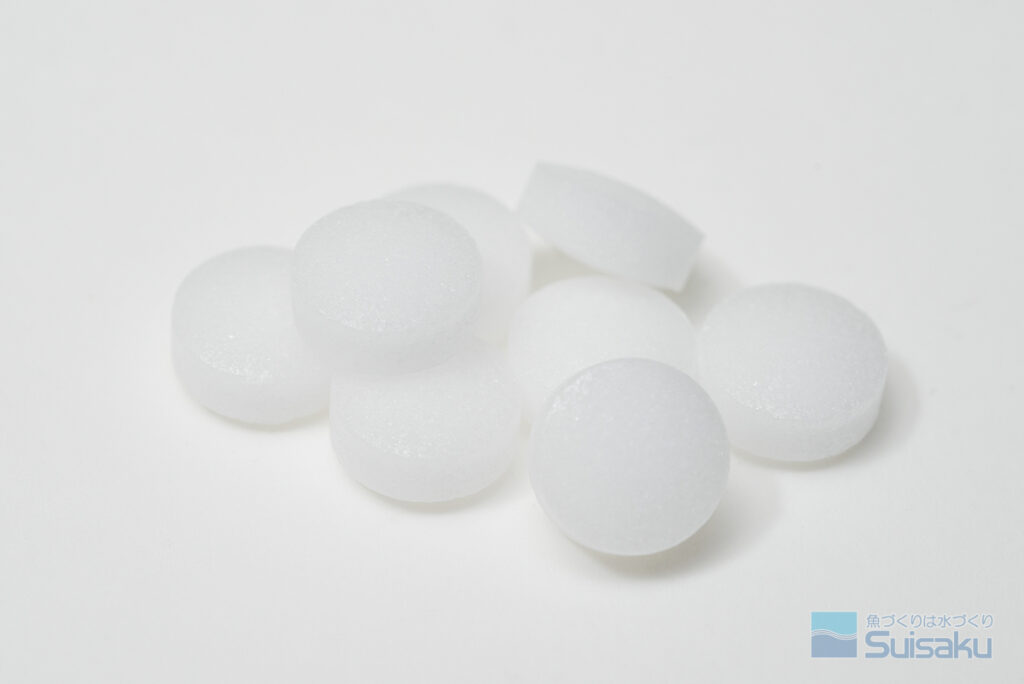
If you get sick
If you ignore the signs mentioned above, you are more likely to get sick. Diseases commonly seen in bettas include:
・Pepper disease
Deterioration of water quality is often the cause of the outbreak, and tiny white pepper-like particles stick to the body and fins. If the condition worsens, death is common, so early treatment is necessary.
・White spot disease
It often occurs due to a sudden drop in temperature, and white particles larger than pepper disease adhere to the body surface. If the condition worsens, death may occur.
・Aeromonas disease
This can also be caused by poor water quality or feeding old food. Symptoms such as scaly scales and pop eye, where the eyeballs protrude, may occur, and in most cases, it is too late.
Most of these diseases are caused by a poor environment or by leaving an unwell Betta fish alone. If the disease is in its early stages, it can be treated by using fish disease drugs appropriate for each disease, but it is important to prevent it from occurring in the first place. Make sure to manage your daily routine to prevent occurrences.
About breeding
Betta fish are fun to collect, but once you get used to keeping them, we also recommend trying breeding them. There are many things to see, such as the unique ecology of building bubble nests, the courtship dance of the male during breeding, and the passionate spawning scene. However, if the sexes are not compatible or the female is not ready to lay eggs, the male may attack and kill the female. Therefore, the quarantine casefloat box S"Females are accommodated and matched with males. If the male builds a bubble nest, he is motivated. The rest is up to the female. If the female shows interest in the male, take her out of the isolation case and place her with him, but if the male seems to be aggressive, remove the female immediately, keep her separately for a while, and then start dating again.
The optimum water temperature for breeding is around 27 to 28 degrees Celsius, and in my experience, males tend to build bubble nests more easily when the air humidity is high. On the other hand, it seems difficult to create bubble nests when the water temperature is low or when cold, dry air enters even if the water temperature is suitable.
Now, I would like to discuss the details of breeding another time. In this breeding example, we housed a Wild Cross male and a Smaragdina Giant female in the breeding tank. If we can successfully photograph the breeding process, we will show you what happens afterwards. Please stay tuned.
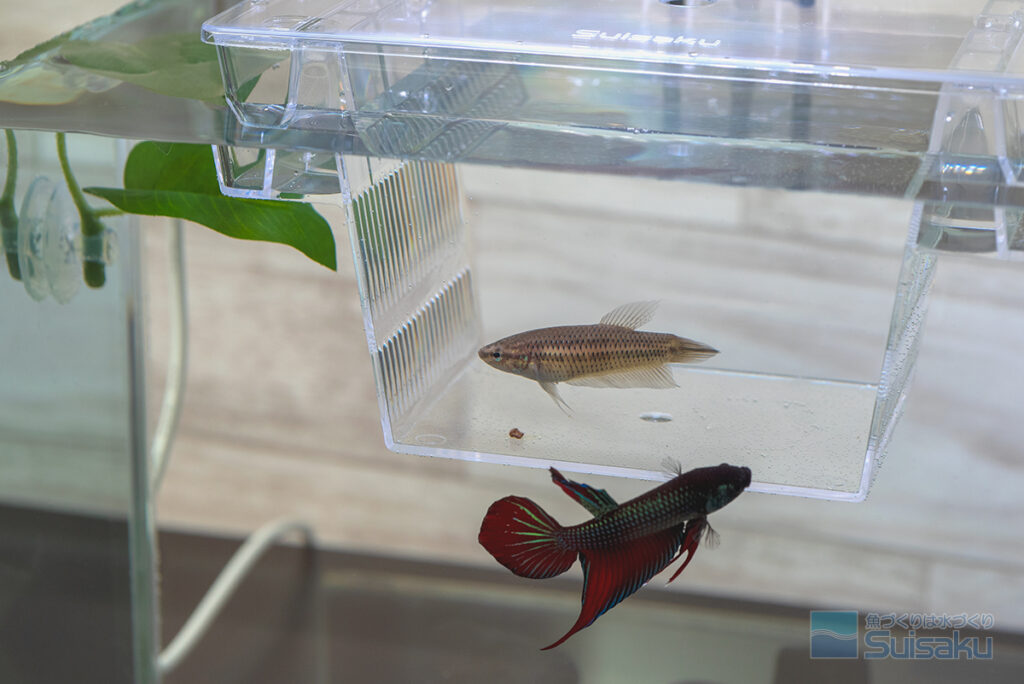
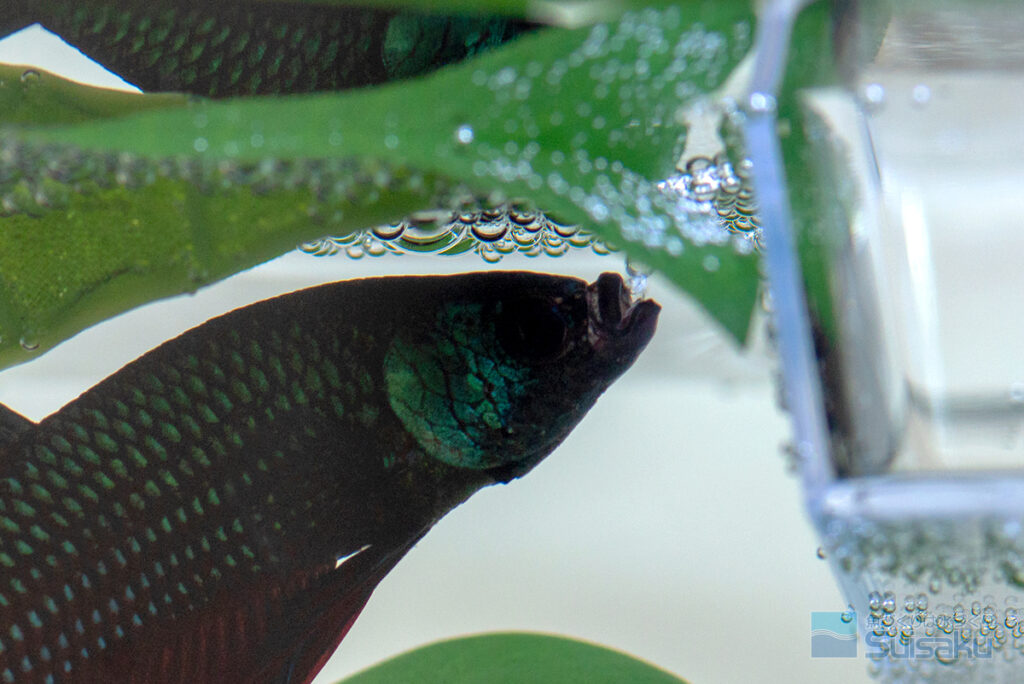
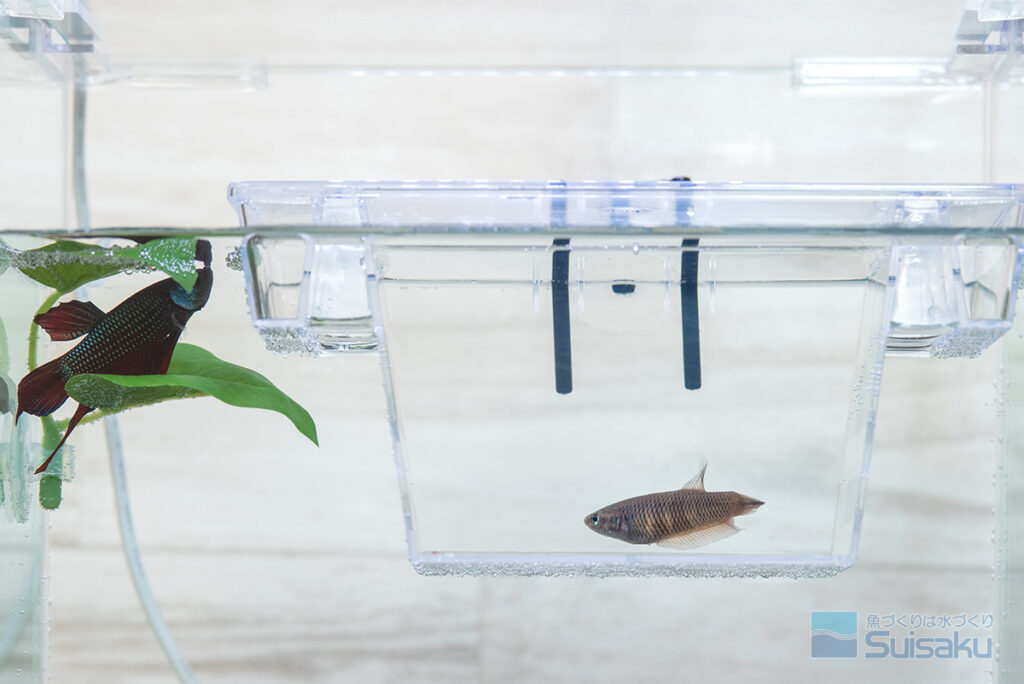
To the end
This time I introduced the Betta Wild Cross, but they are still in the development process. Recently, it seems that breeding between wild crosses and bettas from other categories is progressing, and there is a great possibility that this will have an impact on the appearance of new bettas. If you find a good specimen, try breeding it first. Let's fully enjoy the charm of Wild Cross. see you!













